Mr. Money Mustache's Blog, page 2
July 23, 2023
The Comfort Crisis

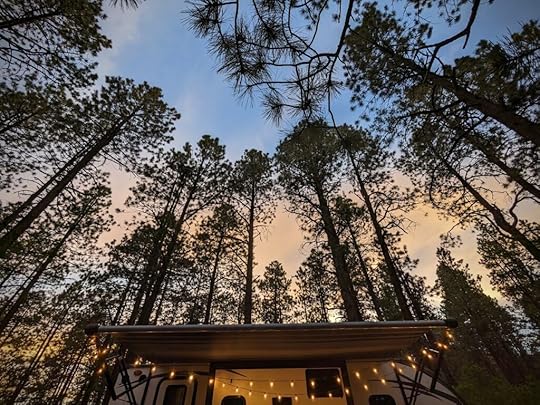
As with many things in life these days, it all started with an episode of the Peter Attia podcast.
In this edition, our nation’s most Badass Doctor was interviewing a guest I initially dismissed as not overly applicable to my own lifestyle. A young,excessively handsome dude who happened to be a writer with a new book out. But the headline of the episode was just intriguing enough to get me to click.
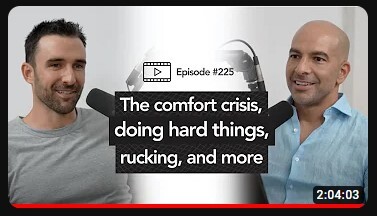
“The Comfort Crisis”
Wow, what an amazing turn of phrase, and what a concise summary of the core of this whole Mustachianism thing I’ve been trying to express for the past dozen years.
While the news headlines cry constantly about our nationwide personal debt crisis or health crisis or any other number of things that suggest that life is so hard these days, I have always seen the opposite: on average, we Americans seem to have a problem of ridiculous overindulgence and easiness in our lives, and our main problem is not recognizing it, and the damage it does to us.
So of course I had to click, and then listen to the whole two hour episode, and then buy the book, and then spend the past month reading and digesting it in small, meaningful chunks like the modern-day chunk of scripture-like wisdom that it is. And wow, am I glad I did so.
The author is Michael Easter, a former writer for Men’s Health magazine was also once catastrophically addicted to alcohol – and descended from a long family line of ancestors with the same affliction.
He was lucky to catch himself from that fall in time to save his own life, and that story alone makes the book worth reading as someone who has stood by helplessly as loved ones battled with addiction. But I think his history with overindulgence in the hollow comforts of alcohol also gives him an edge on writing about the battle between comfort and hardship on the bigger stage of life in general.
So what is The Comfort Crisis about, and how can it make all of our lives better?
The best part about this book is just what a damned good writer this Easter guy is. Like many of the most fun popular science books*, it follows a split narrative which jumps back and forth to interweave the story of an insanely difficult caribou hunting trip he joined in a remote pocket of Alaska, with the appropriate bits of science, psychology and cultural commentary that help us explain and learn from each chapter of the epic shit he had just endured. This allows us to process and apply the lessons in our own lives.
For example, have you ever wondered why the type of bored, rich suburbanites who populate the board of your local Homeowner Association and whine about unacceptably tall weeds or unauthorized skateboarding on Nextdoor are so insufferable?
Why can’t they do something better with their time?
It turns out that there’s a scientific explanation for these unfortunate people, along with most of our other problems:
The tendency of humans to always scan our environment for problems, regardless of how safe and perfect that environment is.
The book cited a study in which researchers told people to look for danger, in an environment which gradually became safer and safer:
“When they ran out of stuff to find they would start looking for a wider range of stuff, even if this was not conscious or intentional, because their job was to look for threats.”
“With that in mind, Levari recently conducted a series of studies to find out if the human brain searches for problems even when problems become infrequent or don’t exist.“
“As we experience fewer problems, we don’t become more satisfied. We just lower our threshold for what we consider a problem.“
In other words, even when our lives are virtually problem free, instead of appreciating our good fortune we just start making up shit that we can complain about instead.
And then our politicians cock their greasy, finely-tuned ears in our direction and make up policies to appease our mostly-insubstantial concerns. And they invent their own trivial “wedge” issues to get us to all bicker about our different cultures and religions, suddenly caring about things that would not have even been problems if nobody told us they were.
And there’s America’s weakness in a nutshell, and meanwhile our strength comes entirely from the times we choose not to waste our time stooping to this level.
Meanwhile, the opposite effect holds true: people who survive in rougher environments than us end up more resilient and less prone to complaining.
In a series of recent interviews, Ukrainian people living in the war zones of their occupied country were asked “is it safe to live where you live?” and a strangely high percentage still said “Yes” – not all that different from the responses of US residents when asked the same question about their own cities.
This adaptation principle also explains why some first generation immigrants tend to build businesses and wealth while their own offspring in second and third generations are more likely to become complacent and spend it down. As an immigrant myself, I can see why this is: conditions were just slightly more harsh and less comfortable and wealthy where I grew up, so I adapted to those conditions as “normal” which made the United States seem posh and easy by comparison. Which made it easier to spend less money and accumulate more.
Tree Therapy
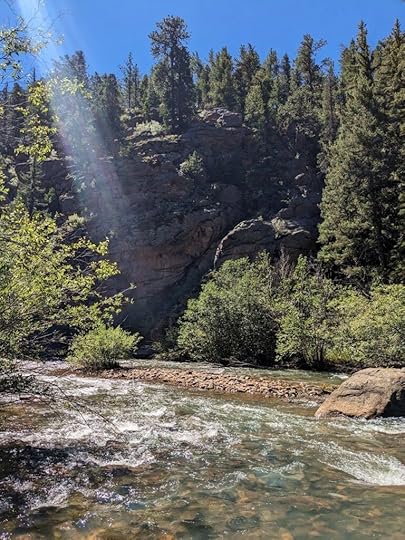
The trap of pointless worry is just one of the many revelations of The Comfort Crisis. It also gives insightful explanations for why spending time in Nature boosts our mental and physical health, while cubicles and car driving grind us down.
There’s something in our biological wiring that responds instantly and powerfully to everything natural, in ways that you can’t get anywhere else.
Even placing a single plant into a hospital room will measurably improve the recovery of almost all patients from almost all ailments. So can you imagine the power of the medicine you are inhaling if you step into a real, living forest? And what if you spent several hours there, or even several days?
Later, we get lessons on our human adaptation towards the ratio of effort to reward:
 It’s proven the harder you work for something, the happier you’ll be about it,”
It’s proven the harder you work for something, the happier you’ll be about it,”
And our bizarre natural aversion to physical exertion:
 A figure that shows just how predisposed humans are to default to comfort:
A figure that shows just how predisposed humans are to default to comfort:
2 (two).
That’s the percent of people who take the stairs when they also have the option to take an escalator.
Which is remarkable, given the absolutely insane cost this tendency imposes upon us.
Moving your body, even a bit, has enormous benefits – again to almost all people towards reducing the probability and severity of almost all diseases. So can you imagine the benefit of moving your body for several hours per day in a natural environment, and including heavy load bearing and bits of extreme exertion?
These things are not speculative pieces of alternative medicine. They are known, easily and reproducibly tested, and proven to be the most effective things we can possibly do with our time.
So why, the actual fuck, are people still sitting inside, watching Netflix, driving to work, and then driving to the doctor’s office to get deeper and deeper analysis of a neverending series of exotic and mysterious and unsolvable problems with their physical and mental health?
We should at least start with the stuff we know is essential – maximum outdoor time every day, heavy exertion including with weights, minimal time spent sitting and driving, and minimum junk food, sugar, and alcohol. You definitely don’t have to be perfect, but just understand that these are the big levers for physical and mental health.
Only then, once you reach these minimum basic things for human survival, should you expect that more exotic and niche medicines and treatments are the only course of action.
By all means, follow your doctor’s orders and don’t just dump all of your medications down the sink because of this MMM rant. But at the same time, realize that the stuff that is hard and uncomfortable is very likely to be the stuff that improves your life the most.
It’s all the stuff that Mr. Money Mustache has been telling you since 2012, but with more detail and less distraction. This book is a concentrated packet of advice for solid living.
Real Life Inspiration from the Good Book
In a happy coincidence, I happened to be in the middle of some hard stuff** of my own as I worked my way through The Comfort Crisis and I found the perspective quite useful and transformative to apply hot off the press.
 Working with a friend to build a cabin.
Working with a friend to build a cabin.Normally somewhat of a homebody, I had embarked on a solo journey for some Carpentourism deep in the mountains of Southwestern Colorado. I had my whole life shrunk down into the new Model Y including food, bed, and the necessary tools and materials to tackle a pretty long laundry list of tasks on two different construction projects (fixing up a mini-resort property in Salida, and starting construction on a small cabin in Durango)
The trip immediately took a turn towards the dramatic as I climbed into the mountains and drove straight into the most torrential rainstorm I have ever seen, then accidentally broke a traffic law in a remote mountain town right in front of both of the local police officers ($115 fine and two points off my license), then five minutes after that had a small pebble hit my brand-new windshield which instantly spread into a crack that spans the whole thing, all before finally limping into Salida to unpack and get started on the work.
“Big deal”, I can already hear you saying, “Retired man experiences two minor incidents while taking a vacation in his luxury car.”
And you’re right, and that is exactly my point.
My life is so stable and comfortable that even these two miniature challenges threw me off balance, and I arrived in a slightly bummed and stressed-out state. But I still knew that in the bigger picture, they are good for me if I accept them as I accept them as the lessons they are rather than choosing to continue to worry about them.
As the trip went on, more things happened, almost as if The Comfort Crisis book were trying to prove a point. I drove three hours deeper into the mountains and up the steep dirt road to arrive at my second friend’s piece of land – a plot of forest in the mountains just outside of Durango.
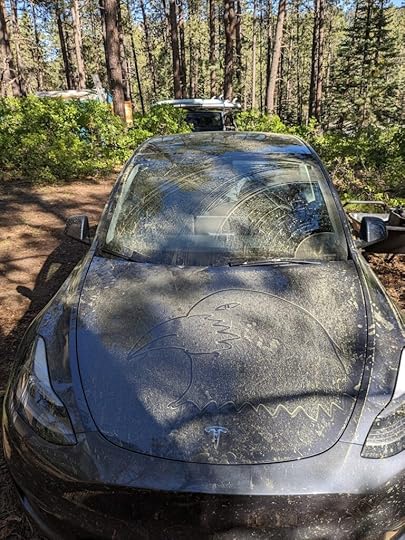 Pollen
PollenMy work days in that high desert environment in the peak of summer were hot and physically demanding. It was hard to keep my tools, and my food supply in the cooler, and myself protected from the scorching sun (and a strange neverending blizzard of tree pollen) while still getting the job done. There was no indoor plumbing and we had to be very careful with our limited water supply. And then at the end of each day I had to reshuffle everything and set my car back up as a bedroom and crawl in for the night. Alone and far from home.
But instead of feeling depressed as I experienced this constant hardship, the opposite thing was happening: I felt more alive and more badass with each passing day. I got better at being a feral forest man.
One day, my co-builder and I decided to take the afternoon off and head to the wild, remote Lemon Reservoir for some paddleboarding. We didn’t bring our phones or any other conveniences or amenities – just two boards and the minimal clothing required for swimming. And we headed out into a stiff headwind and little whitecap waves, laughing at the freedom of the experience.
 Lemon Reservoir
Lemon ReservoirIt was hard, and slightly scary, as we got further and further from the shore. Progress was slow even with serious paddling, and we didn’t have any particular plan beyond the spirit of “let’s GO!”
But again Michael Easter was there whispering in my ear, saying,
“Is this difficult, Mustache? GOOOOoood! Then you’d better keep going!”
So we did. And we got way out into that lake, to a point where the water was shielded from the wind by the mountains on the other side. And it was awesome.
We cruised over to the shore to explore a particularly scenic meadow, coated with the softest green mossy grass and exuberantly colored wildflowers, and set at an impossibly steep angle. And damn I wished that I could have taken pictures, but in a strange way this forced me to burn that spot more thoroughly into my memories using my own senses instead.
Then we headed back out into the center of the lake, set down the paddles, and just laid down on our boards to let the wind and the waves take us back towards the far end of the lake where we had started. And what a strange, serene feeling it was, floating on just a tube of air over two hundred feet of cold blue water, feeling like a jungle man with no cares and no plans and no material possessions. It could have been scary, but instead it was one of the best and most relaxed moments of my life.
Eventually, this week of forest living and exertion had to come to an end so I could get back to my own town to be a Dad again. But it ended with a final reminder of the principles of the Comfort Crisis – after so many days relatively extreme work and a relatively sparse food supply, I had grown used to a healthy background hunger. Which is yet another thing that we are meant to experience as humans – being satisfied and free from hunger all the time is neither normal nor healthy.
But when my hosts took me out on the town for a final night thank you dinner at the Mexican restaurant, the immense Burrito platter I consumed turned out to be the most delicious meal of my life.
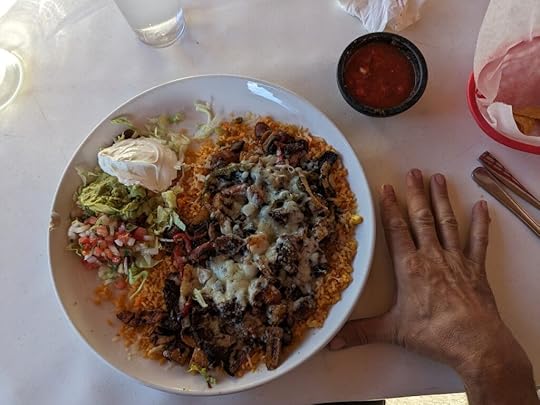 The most delicious meal ever (and the most Immense – hand for scale)
The most delicious meal ever (and the most Immense – hand for scale)Purposeful Hardship vs. Purposeful Spending
There has been a lot of talk directed at the FIRE community recently about how bad we are at spending our money, and how we all need to loosen up. And there’s a small amount of truth to it, as my local friends Carl and Mindy recently admitted during a grilling on the Ramit Sethi podcast.
But we also need to keep this whole idea of excessive comfort in mind, and the damage it does to the natural human condition.
It’s great to spend money on adventures and improving yourself, being generous to others, and making the world a better place.
But it’s also way too easy to fool yourself into thinking you “want” things that just make your life easier and easier.
So your job is to catch yourself before this happens, and learn to keep things challenging, even as you upgrade the rest of your life experience.
In other words: buy yourself better tools, not softer chairs.
—-
* Another great book that follows this style is Wired for Love by neruroscientist Stephanie Cacioppo – highly recommended for reading in parallel with a lover, whether new or old.
** not actually hard by reasonable human standards, but it seemed hard by my comfort addicted first world standards
April 27, 2023
Frugal Man Buys $52,000 Car – Why??
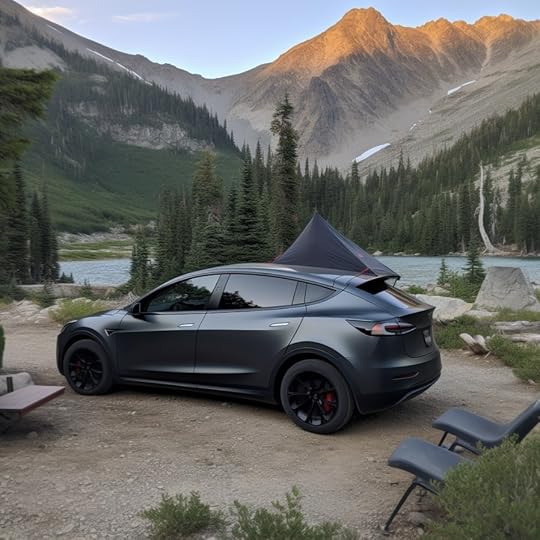
 This is Midjourney AI’s imagined version of my new car. I’ll update this picture once I take delivery and head out on my first real camping trip!
This is Midjourney AI’s imagined version of my new car. I’ll update this picture once I take delivery and head out on my first real camping trip!As I type this, I’m jumping through the various hoops involved in buying a 2023 Tesla Model Y, a spectacularly expensive, large luxury “crossover” that is absolutely loaded to the gills with excess: all wheel drive, faster acceleration than a Lamborghini, enough space for seven people and enough computer gadgetry to function as a small Google data center.
The total net cost of this thing to me after all the taxes and tax credits* will be about $52,000, which is just a stunning amount higher than the Honda van it is replacing. That old classic cost me $4500 when I bought it off of Craigslist twelve years ago, and it had served me dutifully until just last month, crisscrossing the mountains and deserts of this country and also helping to rebuild a considerable swath of houses in my neighborhood.

I’m supposed to be a frugality-oriented financial blogger, and I’m also known for hating car culture – I think most people use cars about ten times more often than they need to, and most people drive cars they can’t afford. So why the hell am I buying a new one?
From those first three paragraphs, you can see I’m feeling plenty of self-mockery and ridicule over this new purchase. If you’re also a naturally frugal person, you can surely relate to the thoughts and you probably also agree with me that I’m off my rocker.
And indeed, I’m still on-board with frugality and healthy self mockery. After all, it was this overall life philosophy that earned me an early retirement 18 years ago, which provides all of the glorious freedom I enjoy now.
It was also the philosophy that allowed me to procrastinate on buying this expensive car for the last four years, even as countless people both close to me and out on the Internet egged me on and told me I should just loosen up and treat myself.
But there’s a classic slogan that applies to many areas of life, and it is something I like to dig up and ponder every now and then:
“What got you here,
Won’t get you where you’re going.”
How does that piece of wisdom apply to frugal living and enjoying a long life of early retirement?
A quick story from a recent run to the grocery store will explain:
I was standing there in the bakery aisle, hoping to restock with a loaf of Dave’s Killer Bread for the next day’s breakfast with some visiting friends. But since this was in a standard grocery store rather than the Costco where I usually shop, the damned stuff was priced at an eye-watering $6.99 per loaf (instead the $4.50 or so I’m accustomed to paying, and even at the bulk store this stuff is about double the price of normal bread).
“DAMN YOU KING SOOPER’S!”
Was my first response.
“WHO THE HELL DO YOU THINK YOU ARE, TRYING TO SELL BREAD FOR SEVEN BUCKS!!!”
Then I went through a whole mental battle of what I call Grocery Shopping With Your Middle Finger:
“Should I just boycott this bullshit?”
“Hmm I wonder if any of the other competing brands are any good?”
“What else is a good substitute for bread for this breakfast?”
And then thankfully, after exhausting all other mental options, I settled on the correct one:
“JUST BUY THE BREAD YOU DUMBASS!”
“Because you are never going to wake up in the future and look at your bank account and think, shit, if only I had an extra $2.49 in there I would be a happier person.”
That night, I came home from the store and shared this funny tale with one of my guests. He understood perfectly because he too had earned his own retirement through a lifetime of grinding in tough jobs and disciplined frugality. And despite the fact that he has a net worth several times higher than mine, he admitted that he faces exactly the same mental battles over splurging on himself.
This same friend gives freely to charitable causes, has supported a local school for decades, and is always the first one to pull out the checkbook if a friend has hit hard times or is looking for a trusted business investor.
But he still has trouble bringing himself to take an Uber to the airport instead of riding the bus which takes an hour longer.
We both realized that we were being too cheap with ourselves, and we needed to work on it. And we came up with a set of three ideas that should hopefully work together to help us have more fun with our life savings, while we are still alive:
the Minimum Spending Budget,the Dedicated Money Wasting Account, and the Splurge Accountability Buddy.Principle #1: The Minimum Spending Budget:
Suppose you’ve done well over the years and amassed a pile of productive investments worth about two million dollars. Yes, this is a lot of money for most people, and that is the point: this hypothetical person truly has it made.
But as it turns out, most Mustachians I know with this level of wealth are still living very efficient lives, usually with a spending level of under $40,000 per year. On top of that, they typically live in a mortgage-free house and still have various forms of side income from a small business or two.
The 4% rule tells us that this person should be fairly safe spending up to about $80,000 per year from that cozy nest egg, even if they never earn any other money.
If this person wanted to be ridiculously conservative and set the spending rate at 3%, that still leaves about $60,000 of fun money every single year.. Plus, again, any side income, future inheritances, and social security income only add to the surplus.
Thus, a reasonable minimum spending level for this person might be $60,000 per year.
And in most cases, they know this, but still go right on living on $40k or less and claim they have everything they could ever want.
But if you watch carefully you’ll still catch them firing up the middle finger at things like $6.99 Dave’s bread or the $14.00 Cabernet at the restaurant or driving around in a gas guzzler even when they would prefer to have a proper, modern electric car.
And whenever these people do get extra money, their first instinct is to stash it away on top of the already-too-big pile. In diagram form, their money flow looks like this:
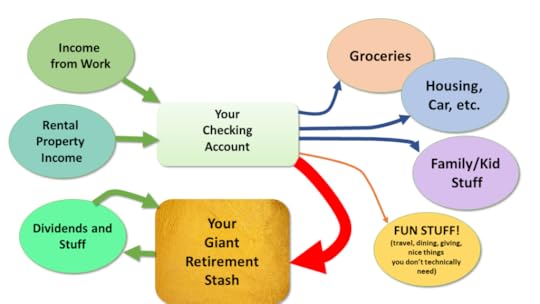
Note that while this person is great at accumulating money through that big red arrow firing money back into the ‘stash, their “fun stuff” arrow appears quite flaccid and withered.
Which is a perfect segue to ….
Principle #2 – the Dedicated Money Wasting Account
Lifelong habits are hard to break, and it’s sometimes hard to “waste” your own hard-earned money on things that seem frivolous, even when you know intellectually that you have way more money than you’ll ever spend.
But have you ever noticed that if you are spending somebody else’s money, preferably an anonymous corporation, it feels different?
For example, when you’re on a business trip and you just show up at the dining table to eat and drink and you never see the bill, you probably don’t fret about the prices, right?
The key is to make your own money feel like somebody else’s, and you can do it like this:
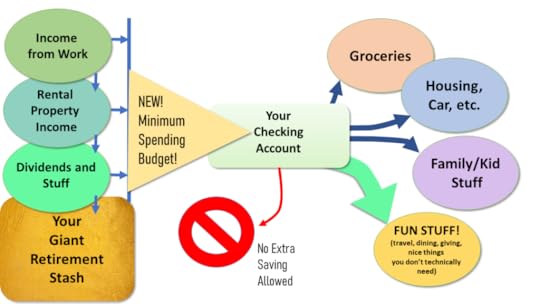 Re-brand your main bank account – henceforth it is the FREE FUN MONEY account. Set up an auto-deposit of your minimum spending budget that drops in each month (if you suspect that you might currently be too frugal, make this at least $1000 per month higher than your current spending level)The only way you are allowed to use the money in this new account is to spend it on anything and everything, or give it away. It can be used for both necessities like groceries and your utility bill, but also your luxuries like travel and dining and generosity.
Re-brand your main bank account – henceforth it is the FREE FUN MONEY account. Set up an auto-deposit of your minimum spending budget that drops in each month (if you suspect that you might currently be too frugal, make this at least $1000 per month higher than your current spending level)The only way you are allowed to use the money in this new account is to spend it on anything and everything, or give it away. It can be used for both necessities like groceries and your utility bill, but also your luxuries like travel and dining and generosity.But the key rule is this: You are not allowed to follow your old habit of sweeping out the surplus each month to buy more and more index funds as you’ve been doing your whole life.
If the free fun money starts building up, which it probably will because you are way out of spending practice, it will stare you in the face and tell you to do a better job.
And this can and should be FUN! Now you can get the best organic groceries even when the price seems exorbitant. Go out for dinner or order delivery whenever you like. Surprise your loved ones with concert tickets, join your friends on snowboarding or beach trips, or even pay for an entire group vacation, allowing people to go who couldn’t normally afford it so easily.
Technical Note: Some people have income or wealth levels are so high that it would be insane to spend at a 3% rate. For example, a $10M fortune would lead to a $25,000 monthly spending rate, which is obviously ridiculous.
In this situation, you can still leave your dividends reinvesting but still give yourself a bigger, no-saving-allowed budget to get some practice being more relaxed and generous. The real point here is to just stop sweating the details so you can have more fun.
Principle #3 – The Splurge Accountability Buddy
Many of us frugal people tend to stick together. And most of us have different versions of the same problem: we know logically that money is plentiful these days, but our emotions keep us stuck in our old ways of optimizing too much.
But I find that when I team up with local friends who are actually trying to battle these same habits, we can question each other’s decisions, call out cheapness when we see it, and cheer on splurges when we know the other guy would enjoy it.
My super wealthy friend from above has become much better about treating himself (and his family) to quality goods for the home, amazing trips together, and just a general reduction in his stress over being “efficient with money”
My friend and HQ co-owner Carl (Mr. 1500 Days) has finally replaced his beaten-down minivan with a spiffy new Chevrolet Bolt electric car, and is loving that leap into the future.
And of course Mr. Money Mustache, after squeezing one final mountain road trip out of his 23-year-old Honda van, is finally allowing himself to get the Tesla he has been talking about for half a decade.
 An early spring Sunrise at our new “Friends Mountain Resort”
An early spring Sunrise at our new “Friends Mountain Resort”A recent life change (becoming a co-owner of a fixer-upper vacation rental compound in beautiful Salida Colorado) has reignited the travel fire in my heart and made me realize how much I do love getting out to distant places for visiting, mountain biking, gathering with groups of friends and my favorite activity of all: Carpentourism.
Running the Numbers: how ridiculously expensive is this car?
This is the perfect start to my experiment in spending more. Realistically, a $50,000 car is going to cost me about $10,000 more per year than my old van was burning. With the biggest costs being these:
Since I personally had a spending deficit of several times more than $10k per year, I figure this is a solid first step. And, since the car’s primary purpose is things like epic camping trips, dream dates, and long adventures around the country, it will definitely help me spend more on experiences, hotels, and go out to dinner a bit more often as well.
“This Privileged Rich Folk Talk is Making Me Sick, why don’t you give your money away to charity, or to me?”
In general, I agree: the world has problems and the richer you are, the more you should consider giving generously.
But also, to be honest, the whiny people who constantly send complaints like this out to strangers on the Internet really need to get a life. It’s great to encourage philanthropy through positive examples, but completely unproductive to send negativity to shame people you don’t even know for not following your own personal value system. The world has seen more than enough of this.
On top of that, this one-sided thinking can be counterproductive. Both of my friends have given generously throughout their lifetimes. In my own case, I have donated over $500,000 to the best causes I could find during the years I’ve been writing this blog, but I was still refusing to let myself replace that 23-year-old van.
And that overthinking was leading to even more of a scarcity mentality, as I compared my own meager spending to these bigger numbers of my donations, and found myself thinking things like,
“Damn, I’m spending $100 on this dinner date which sounds like a lot, but I also spent ONE THOUSAND TIMES more on donations last year, which sounds like even more. Maybe I am spending too much and need to cut back on EVERYTHING!”
And then the fear side of my brain would illogically chime in: “Yeah and you’re going to make us run out of money and be poor forever! waaaah waaaah! Cut back and optimize and conserve!”
I think there is a happy medium here.
Yes – be a super, duper responsible stewart of your life savings.
And yes, give generously with all your heart to charity.
But yes, it’s also okay to set aside a portion of the money you’ve earned, for frivolous spending on yourself and those closest to you. You’re not a bad person for having a few nice things.
It’s okay to pay that extra hundred bucks to sit in the front of the airplane instead of the back if it helps you enjoy your vacation and spend a joyful half hour walking FREE at your destination while the 49 rows of people behind you fuss infuriatingly with their shit in the overhead bins.
It’s okay to buy the frozen berries at Whole Foods even though they cost eight times more than Costco charges, if it spares you from making a second unpleasant trip through parking lot hell.
And as for me, I am calling it okay to, at last, double flip the Autopilot stalk in my new Tesla and lean back as it it shoots me gracefully through even the highest mountain passes, forever leaving the desperately underpowered wheezing and gear shifting and noise* of the gasoline era behind, forever.
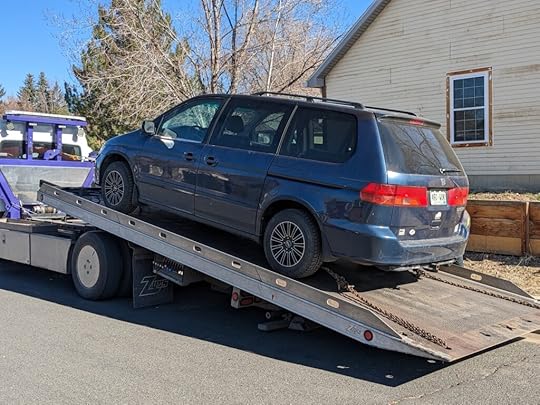
Rest in Peace, Vanna – 1999-2023
* A useful tip for more effective splurging:
Try to find the truly negative aspects of your life and focus any additional spending on improving those things. But it’s a subtle art so you have to get it right if you want lasting results in happiness.
You don’t want to just reduce hardship or challenge like hiring someone to take care of every aspect of your house, because overcoming daily hardships and having significant accomplishments provides the very core of our life satisfaction.
You also don’t want to just upgrade the things that are already good in your life. For example, a friend of mine is a gourmet coffee expert, and he suggested that I upgrade my setup at home to include on-the-spot roasting, and fancy grinding and brewing equipment. But I already love the good quality coffee I buy off the shelf from Costco, so it would be counterproductive to invest time or money into changing this part of my life.
But when you have something that causes you regular angst and stress, whether it’s a leaky roof that makes you dread rain, or a long commute that makes you dread the daily traffic jam, or a body that is giving you trouble due to not being in the best of shape – those types of things are probably a good target for improvement.
In the case of my car situation, I had a Nissan Leaf which is wonderful to drive, but doesn’t have the range to travel anywhere outside of the Denver metro area. Then I had the van which is a clunky beast to drive, but is otherwise an amazing road tripper because I could bring along whatever and whoever I wanted. But the van was getting increasingly unreliable in several hard-to-fix ways which was making me nervous every time I thought about long distance travel. Which was causing me to avoid certain trips and miss positive lifetime experiences.
In other words, my lack of a reliable long-range car was a small but consistent source of negative stress.
Finally, Vanna gave me the gift of a final hot and smelly transmission failure on a mountain pass on the way home from my new project in Salida. It was just the nudge that I needed. And now I already feel excitement rather than dread at the prospect of all the road trips in the coming decades!
* Total cost of this Tesla:
Model Y plus options and Tesla fees: $53,630 Subtract $7500 federal EV tax creditSubtract $2000 Colorado EV tax credit(Note: this is equivalent to a $44,150 list price if you are cross shopping with other cars)Add back in $4674 of sales taxAdd in first 3 years of Colorado new-car registration fees: $3000Net cost: about $52,000New Tracker Page!
To go along with this article, I started a new page called “The Model Y Experiment” where I can share ongoing findings and Q&A about the ownership experience. I’ve driven and rented Teslas quite a bit in the past, so most of it will be pretty familiar. But as an owner I’ll get to verify the reliability and the quality of customer service, as well as any quirks and modifications and upgrades I do.
April 7, 2023
Less Cars, More Money: My Visit to the City of the Future
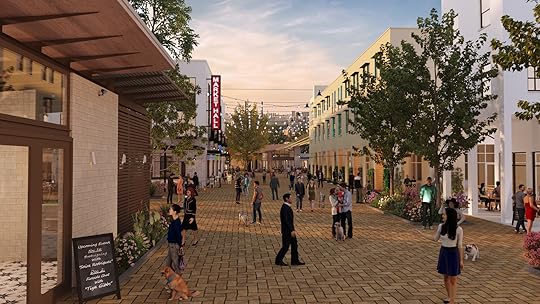
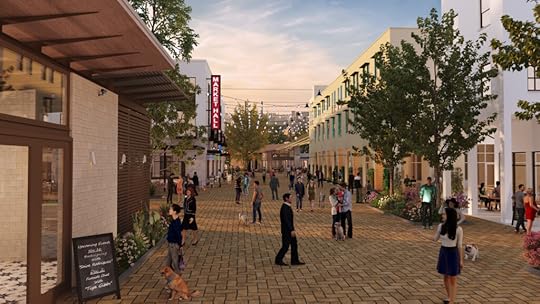
In my role as Mr. Money Mustache, I do my best to be your one-stop-shop for Lifestyle Guru ideas. So over the years we’ve covered not just the Money side of life, but also the even more important stuff like health and fitness and the psychology of better, happier living.
But there’s one single area of life where all of these factors come together with an almost Nuclear Fusion level of synergy and effectiveness. And because of that, if I could have one single wish in the world, this is what I would wish for. It’s a change so massive that it would make every person on the planet better off and fix most of our problems in one grand sweep. And it’s probably not what you’d expect:
That we immediately switch to building our cities and countries around people, instead of cars.
(and then fix all of our existing ones too, so that our entire world is built around person-friendly living.)
The benefits of this are way bigger than almost anyone can imagine. We’re not just talking about eliminating a bit of pollution or a few traffic jams or car crashes. No. This is about far richer, healthier, and most importantly more fun living for everyone.
To put even conservative numbers to this, we’re talking about a life boost of over $20,000 per person per year, which compounds into well over two million dollars per adult lifetime.
On a nationwide scale, this would boost the wealth of the United States by about seven trillion dollars per year, which would compound into about 770 trillion over the next five decades.
Which happens to be more than the current total amount of human wealth on the entire planet.
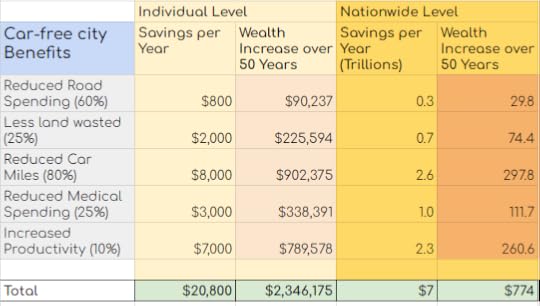 City design dictates the biggest numbers in the world.
City design dictates the biggest numbers in the world.You will have a house that is both cheaper and more beautiful and spacious. Your body and brain will be healthier and stronger and sexier and cost a lot less time and healthcare dollars to maintain.
And all of our wallets and investment accounts, both public and private will be absolutely overflowing with surplus income, reduced expenses, and fuel an investment and prosperity boom like the world has never seen.
“WTF?”, you may ask
“Isn’t city planning just a stuffy thing that your city council does in the background while we’re all off living our lives?”
Well, yes it is right now. And that’s the whole problem: cities are built by people whose primary job is to maintain the status quo and prevent disruptions. And those committes are elected and encouraged by crusty old companies and organizations, and plain old grumpy neighbors who just don’t have the vision to see what they are missing.

I’m convinced that if everyone could see through the smoggy haze of the status quo, we would all agree that this idea of a radical change is not only the best idea, but the only reasonable idea to even consider.
So our job is to learn and explain just how big and how easy this is. And what it boils down to is pretty damned simple.
Let’s start with this picture
 image credit to the excellent DenverUrbanism website https://denverurbanism.com/2016/12/choosing-to-build-two-parking-spaces-or-two-bedrooms-shouldnt-be-difficult.html
image credit to the excellent DenverUrbanism website https://denverurbanism.com/2016/12/choosing-to-build-two-parking-spaces-or-two-bedrooms-shouldnt-be-difficult.htmlWhoa, that’s a bit of a surprise.
So for the same amount of space you can have an entire pretty nice two bedroom apartment, or you can have just enough space for two (small) cars to park and pull out. But it gets even crazier than this. Check out this random intersection here in my own city:
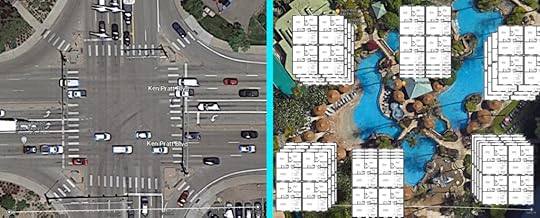 A big intersection is about 250×250 feet.
A big intersection is about 250×250 feet. On a good traffic day, you’ll blow right through it.
But this is actually 1.5 acres of wasted space, enough to house about 200 people in resort-like comfort!
WHAT?! So every time you have two big car roads intersect, which happens hundreds of times in every big city, you are wasting enough space to build a luxurious, resort-like living area with about one hundred two-bedroom apartments and still have room for a pool, a dog park, a grocery store, a couple of restaurants, and so on.
This is just the beginning of the insanity, because I have only shown you two parking spaces and one intersection. The reality is that our entire cities are made almost entirely of stupid, expensive wasted space like this.
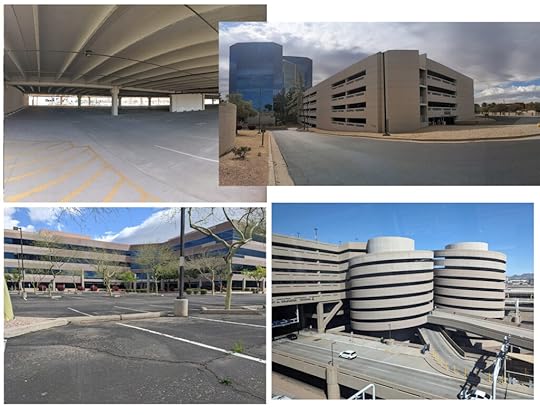 Most of the city of Phoenix is OBSESSED with cars. Infinitely large parking garages, parking lots, and of course roads. But most of it is wasted (I took these pictures during a long exploratory walk I took in the middle of a work day.)
Most of the city of Phoenix is OBSESSED with cars. Infinitely large parking garages, parking lots, and of course roads. But most of it is wasted (I took these pictures during a long exploratory walk I took in the middle of a work day.)And the problem is so extreme that the only reason we think we need cars to get around, is because we have wasted most of our space on accommodating cars, which spread everything out so far (and made everything so loud and dangerous) that nobody feels like walking or biking!
Cue the Complaints

Whenever you propose any great new idea, you’ll always get a bunch of smartasses who like to complain and resist change, without even bothering to think it through.
Most of them boil down to,
“But how are we going to keep driving our cars just as much as we do now?”
Which is ridiculous – because the whole point is that as soon as you cut out all the huge wasted spaces we create to accommodate cars, you are suddenly FREE from needing cars so much!
Instead, you can just weave a brand new city, with a bunch of variations of this beautiful resort which also include offices, grocery stores, climbing gyms and every other amenity.
And yes, you’d still have some roads between them, but they would be mostly for deliveries, emergency vehicles and people who need mobility assistance.
I hope you’re not going to make me ride the bus?
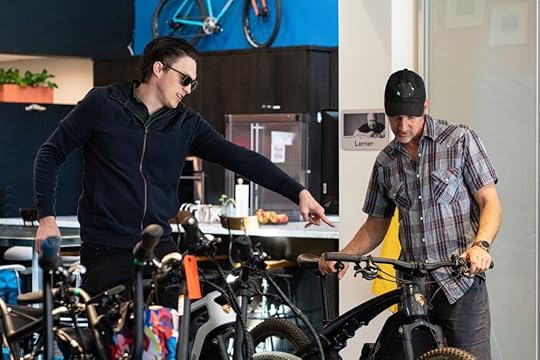 Checking out one of the 60+ Electric Bikes at the HQ of the country’s first car-free neighborhood.
Checking out one of the 60+ Electric Bikes at the HQ of the country’s first car-free neighborhood.I am all for public transit in theory, but to be honest I don’t usually have the patience for it. I don’t do lineups, and I don’t like stand around waiting passively for my transportation to arrive – when it’s time to go somewhere, I just want to go, and go now, and get there fast. So my own personal choice is to take a bike for short distances (under 2 miles) or an e-bike for larger ones (up to about 15 miles).
Although this is often news to car drivers, bikes are much faster than cars for urban transport, plus they give me exercise and thrill, which is way better than being stuck at the red light with the cars.
If you take this already-superior method of urban transport and cut out the 90% of the land that we waste on accommodating the inferior cars, then you end up with a revolution: everybody gets where they are going ten times faster, at much lower cost, and has much more fun doing it.
And sure, there will also be light rail and faster buses. And sure, you can still hop in an Uber or even bring your own car into a city like this.But the point is that it will just happen much much less often.
Okay I’m convinced, but how can we actually accomplish this?
Mr. Money Mustache can talk a big game with all these fancy words and pictures, but the truth is that I’m way too impatient to put up with all the bureaucracy and complaints that arise when you try to actually change a city. I’ve been doing my best here in Longmont, and I have gotten just about nowhere. We’re still just stacking on more and more layers of ridiculous car shit where I live.
Thankfully, other people are much more patient and effective than I am at affecting change, and one group has made such incredible progress that you can now go LIVE in their first creation: a 1000-person car-free neighborhood called Culdesac Tempe. And as I write this, I am staying in a hotel right nearby, having spent the past two days touring and visiting and interviewing the founders*.
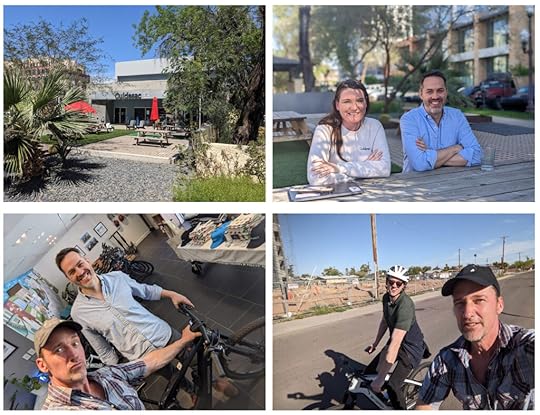 Clockwise: Culdesac office replaced their own parking lot with a mini-park. Culdesac head of marketing Blythe Ingwersen and co-founders Jeff Berens and Ryan Johnson showed me around and lent me a nice Porsche e-bike for a tour of the city!
Clockwise: Culdesac office replaced their own parking lot with a mini-park. Culdesac head of marketing Blythe Ingwersen and co-founders Jeff Berens and Ryan Johnson showed me around and lent me a nice Porsche e-bike for a tour of the city!While we were at it, my Phoenix-area-house-fixing friend Tracy Royce and I also hosted a meetup for an enthusiastic group of our readers/viewers right there in Culdesac’s emerging central plaza.
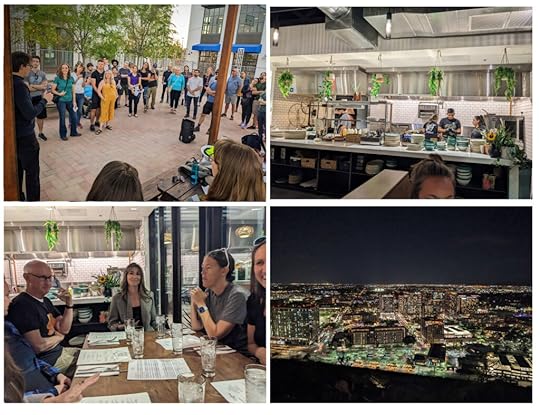
Culdesac is Awesome and Could Change Everything
If you only look at the financial spreadsheet, you would think this first Culdesac project is just going to be a highly profitable 1000-person cluster of apartment buildings, spread out across 17 acres of land. And while financial sustainability is indeed a key reason why this model will succeed, the money is the least exciting part.
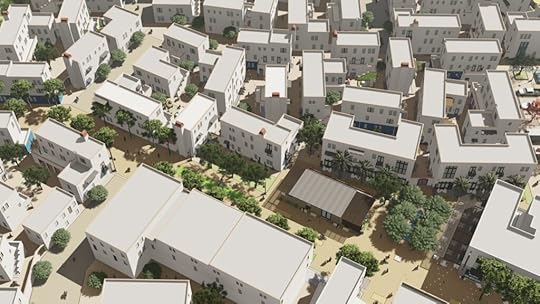
When you look at these pictures compared to a normal housing complex, the main thing you will notice is that all the space that would normally be wasted on parking lots, is instead used for beautiful walking and gathering areas.
The next big upgrade is that they mixed in the amenities for daily life right into the neighborhood, rather than forcing all the future residents to get into their cars to drive out to find them:
Grocery store, similar in style to a small-ish Trader Joe’sFantastic gym (which I got to tour – it is a beauty!)Coworking space Dog parkPoolOutdoor kitchens and shade structures and garden areas galoreSemi-fancy Mexican restaurant with ample patio spaceAnd lots more retail space also in the construction plansI was also impressed with just the feel of walking the Mediterranean-vibed spaces between the buildings, even at this early stage when everything is still under construction.
Due to the hot desert climate of the region, everything is built around providing shade, breeze, and reflecting heat during the summer, while also maximizing the joyful fact that there is no winter there (the coldest month of the year still has an average daily high of 65F/18C, which means palm trees, leafy gardens and fruits and flowers forever.)
With a setup like this, and 999 new neighbors to meet, I would rarely feel the need to leave the place. Which really cuts down on my desire to use a car. But on top of that, Culdesac has strategically placed itself in Tempe, a city right in the center of the Phoenix metro area, within walking distance of the main university and right on a light rail stop which allows you to reach almost everything (including the airport) for FREE, since an annual pass to the transit system is included with your rent.
But of course, you can also get around on foot, bike, e-bike, scooter, or hop into one of Culdesac’s fleet of rideshare electric cars for a trip to the mountains or whatever else you might want to do that’s outside of bike and transit range.
It’s insane. In fact it’s so good that I am going to attempt to move there myself at the end of 2023, enjoying my first escape from Colorado winter and celebrating the fact that my boy will be a legal adult at that time.
But even this is just a pilot project because Culdesac has much bigger plans.
The Culdesac Master Plan
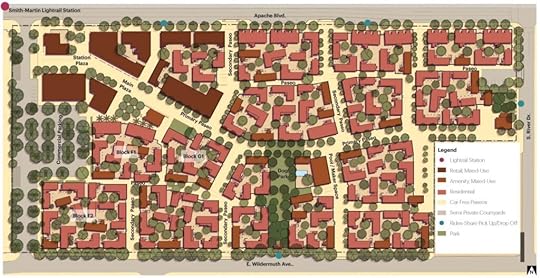 An early sketch from Culdesac’s architecture firm, Optico Design. Isn’t it amazing what you can fit in a single Big Box shopping center parking lot?
An early sketch from Culdesac’s architecture firm, Optico Design. Isn’t it amazing what you can fit in a single Big Box shopping center parking lot?From my conversations with the founders, I think they want to do this:
Start with this small-scale community of rentals, just because it’s fasterUse this to get the word out and learn from the experience before going biggerMove up to a larger-scale communities which will also include homes for saleGo REALLY big, and make an entire section of a city, then eventually an entire town which grows into an entire cityMeanwhile inspire the rest of the United States to go the same way, once they see that this type of neighborhood is both more desirable for people, and less costly (therefore more profitable) to build.So How Can We Benefit From This, and Support it?
 We need MORE of this!If this article gave you any surprising new information or changed your perspective at all, you’ve already made a difference. Because your choices around housing and transportation will probably shift at least a little bit away from cars, which will change our future demand and development patterns to be at least a little bit better. Congratulations!If you’d like to be one of the first residents of this first neighborhood, sign up right on their website at https://culdesac.com/ . There is a waiting list, but it moves faster than you would think – especially if you have a flexible moving date.If you’d like to make your own city a better place to live, just start emailing your own city council, or even better, sign up to serve on your own local planning board or city council yourself, as the heroic gentleman from Twitter did above. The things to push for are: approve more housing and more bike paths, but eliminate minimum parking requirements and above all stop wasting money on road expansions! Every dollar spent on accommodating cars subtracts many dollars from the future wealth of your city.If you are a major investor ($10M+) or land owner (20+ central acres in a high-density city) looking to invest in and boost this effort, email the team directly at investors@culdesac.com – more info on their about page.
We need MORE of this!If this article gave you any surprising new information or changed your perspective at all, you’ve already made a difference. Because your choices around housing and transportation will probably shift at least a little bit away from cars, which will change our future demand and development patterns to be at least a little bit better. Congratulations!If you’d like to be one of the first residents of this first neighborhood, sign up right on their website at https://culdesac.com/ . There is a waiting list, but it moves faster than you would think – especially if you have a flexible moving date.If you’d like to make your own city a better place to live, just start emailing your own city council, or even better, sign up to serve on your own local planning board or city council yourself, as the heroic gentleman from Twitter did above. The things to push for are: approve more housing and more bike paths, but eliminate minimum parking requirements and above all stop wasting money on road expansions! Every dollar spent on accommodating cars subtracts many dollars from the future wealth of your city.If you are a major investor ($10M+) or land owner (20+ central acres in a high-density city) looking to invest in and boost this effort, email the team directly at investors@culdesac.com – more info on their about page.And Then What Will Be Our Payback?
This whole change is exciting, and it is immense.
Understanding these ideas around city planning is the economic and social equivalent to being a doctor, and finding a 35-year-old patient in a hospital who is suffering from every chronic disease, but then discovering that they have been following a diet of Coke and Donuts for their whole lives and never been out on a walk, once.
In other words, the changes are so obvious, and the amount of win/win synergy so great, that every step we take towards making our cities better, and every car trip we eliminate, will absolutely explode our personal and national wealth upwards for generations to come.
The stakes just couldn’t be higher.
Are you in?
Further Reading:
Another collaborator in the overall effort for car free cities is a bank-founding multi entrepreneur local friend named Kevin Dahlstrom. His recent Twitter rant on building car-free cities from the scratch gathered a shocking amount of very positive feedback and interesting comments.
* Despite my positive raving about this neighborhood, I have no financial or business connection with the project or any of the team members. I am just really excited about their work and want them to succeed!
February 26, 2023
How to Build a Kitchen (and Why)

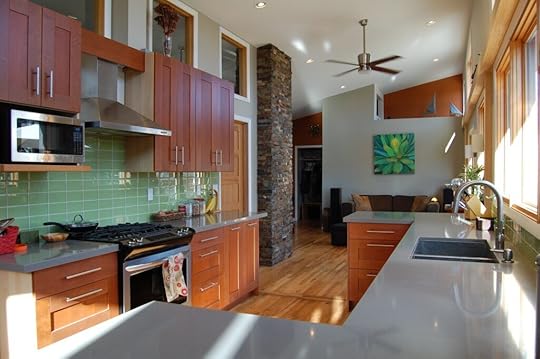
Well, looks like it has happened again.
Since the last time we spoke, I got sucked into building my 17th(?) kitchen, and I have finally emerged from its messy yet addictive grasp as I stand here at the new breakfast bar, typing this report to you.
Why am I so hooked on this strange pastime? And more importantly, why am I so excited to tell you about it, when most MMM readers probably don’t have house building at the top of their list of life priorities?
It’s probably because the concept of home is such a core part of life for me: a place that allows us to take care of our families and ourselves, host friends and build our lives outwards from there. And to me the most important part of a home is the place where you prepare and stash your food supply, which also happens to become the spot where our kids spread out their homework, we have our deep talks, and the natural gathering point for just about every party.
There is of course a money side to all of this too: housing is the most expensive thing in most of our lives (including my own), and this cost has exploded upwards in recent years due to a crazy imbalance of supply and demand.
People want homes with beautiful, highly functional amenities like kitchens and bathrooms, which means those houses get bid up to higher prices by those willing to wildly overpay, which leaves the more investment-minded among us swearing at the irrational market conditions, or buying ugly fixer-uppers as a compromise.
This leads to a second shortage: a shortage of tradespeople like myself, because there are a lot of flimsy little sinks, leaky plastic-handled faucets and fake woodgrain oak cabinets out there, but not a lot of people with the experience to rescue that 1982-style kitchen and bring it into our glorious modern present.
Which means that if you can even find someone willing to build you a new kitchen, you’ll often see quotes from $25,000 to north of $75,000 for the prestigious but not-all-that-difficult job.
As you’ll see below, this translates to an incredibly expensive labor rate of between $100 and $300 per hour, which is money you get to claim for yourself if you are willing to do some of the work. And the rewards can be even higher than that, because when you upgrade a kitchen in an expensive housing market, you typically create even more than $25-75k of additional value. This will flow back to you in the form of more cash when you eventually re-sell, or higher rental income every single month if you are fixing up a rental property.
And one more real estate secret: a kitchen is effectively just a really big fancy version of a bathroom, so if you learn the skills you can do either one. Imagine the God-like power of being able to point your finger and call into existence kitchens and bathrooms where none existed before!
So in this article, I’m going to whisk you through a high-speed tour of the main steps of rebuilding a kitchen, focusing on the things that make the biggest difference in function, cost, and difficulty – in other words, the things I wish I knew 23 years ago when I started working on my first kitchen.
We don’t have space here to cover every detail of every step, but as with any important endeavor, it’s best to start with the big picture anyway. And from there, I hope to leave you with a much more empowered starting point to do one of three things:
To know what to look for (and how to tune your Bullshit Meter) when hiring someone else to build you a kitchen.To strategically break off parts of the work you want to do yourself, to save time and money even if you hire out the rest.Or even to do the whole thing yourself, seeking help from more experienced friends or YouTube videos as needed to get the full details.So let’s get into it! The ten main steps to designing and building the most joyful room in your house.
Step Zero: Do You Need a Permit?
In most areas, this is a “Yes” if you are messing with plumbing and electricity inside the walls, otherwise it’s “maybe”. But rules vary widely around the world – I’ve worked in some places where the inspectors will come knocking if they see so much as a scrap of drywall poking out of your trash can, and others where people build a whole barn without raising the eyebrow of the authorities. But whether you get a permit or not, the most important part is to do the job right – this means tidy, professional work that meets the local building code and would pass an inspection even if nobody will see it. It will allow you to sleep well and avoid troubles down the road.
1: Figure out the Cost
This one is obviously all over the map depending on your tastes, but we can start with the following overly simplified table:
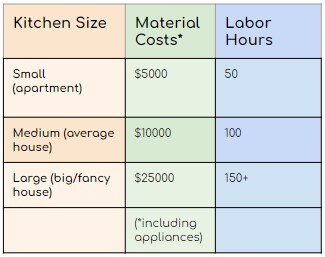
The dollar figures are just for the materials including appliances, and the labor hours are what I’d budget for myself or another professional – you can adjust as needed based on your own skill level. Later we can cover the simple spreadsheet that I used to come up with those numbers.
Super Duper Shopping Pro Tips:
 Here’s a recent example – shocked by Home Depot’s sudden price increase on sink traps, I checked Amazon and sure enough they were still the proper price of about three bucks. So I bought five to re-stock my inventory because I just know there are many more kitchens (and bathrooms) in my future.
Here’s a recent example – shocked by Home Depot’s sudden price increase on sink traps, I checked Amazon and sure enough they were still the proper price of about three bucks. So I bought five to re-stock my inventory because I just know there are many more kitchens (and bathrooms) in my future.When it comes to cost-efficient renovations, material sourcing is everything. Here are a few of my own favorite tricks:
Craigslist, Facebook Marketplace and Recycled Building Material stores are amazing. It takes more time and skill to find and use materials from these sources, but in exchange you get your stuff for about 75% less. In the past I’ve bought a $2000 fridge for $500, doors and cabinets and light fixtures for next to nothing, and stocked up on reclaimed wood and steel pieces worth tens of thousands of dollars for free, in exchange for a few hours of my time.But sometimes you have different goals, like faster speed or or the higher-end finishes that are only possible with brand new materials. In this case, you move down the list.Amazon is now better than Home Depot for many things. Light fixtures, sinks and faucets, even saw blades and big rolls of PEX pipe. All with a way wider selection, fast shipping and at lower prices than the older retailers. I’ll still get my lumber and drywall and paint locally of course, but for everything else I check online first. The bonus is that this also cuts down my mid-project trips to the store by about 80%.
IKEA kitchen cabinets usually offer lower cost, easier/faster design, and – surprisingly – better overall quality than what you get with special order cabinets from the home renovation stores. More on this in the cabinets section below.
2: Layout (and knocking down walls!)
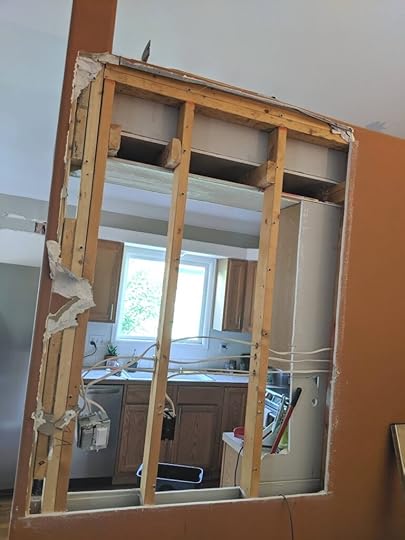 Ahhh, my favorite thing ever: removing unnecessary walls!
Ahhh, my favorite thing ever: removing unnecessary walls!The basic principle I like to follow in kitchen design, at least for the smaller and older houses that those of us in the fixer-upper crowd tends to purchase, is MORE:
More floor space and countertopsMore open-ness to the rest of the houseMore storage, especially drawersMost houses from past eras have the kitchen walled off into a tiny booth. And the good news is that you can usually just chop down the unnecessary walls between that booth and the living room, replace one of them with a nice spacious island, and transform your house for the better.
Bonus! How to figure out if a wall is load bearing:
My safe answer here is, “Ask a structural engineer or at least a house builder”, but since I’ve done a lot of both activities, here is a shortcut:
Figure out what’s over top of the wall in question (is it an upper floor or just the roof?)If it’s the roof, peek up into the attic. If the house is a newer design it may have trusses. In smaller houses (up to about 30 feet wide), this usually means all the weight of the roof is resting on the outside walls, meaning most or all the interior walls are just cosmetic.If your kitchen is on the first floor with another level above, the wall may be load bearing, especially if it is perpendicular to the floor joists above it. In this case you can still open up the wall and replace it with a beam and posts. But that’s a task for experienced builders – bring in some help if you don’t know how to do this already.Basic Layout Principles
As a quick example, let’s use a case study of one of my own rebuilds to point out both things I think did work, and other places I made some mistakes and would do things differently next time. (This was in my own house, so you’ll have to forgive my taste for somewhat wild colors!)

Whoo! Okay there’s a lot of info in there, but it’s worth reading through because it captures many of the things I like to cover in a new kitchen. The biggest principle to follow is just to give everything enough space – especially the chefs themselves. This sometimes requires clever space-saving tricks, but it’s also why I end up moving or removing walls so often. Small spaces in your own house suck!
Design Shortcut: The IKEA Kitchen Planner

To figure out how everything will fit (and look), you need at least some scale diagrams, but even better is a 3-D model that you can look around. There are lots of options here ranging from old-fashioned graph paper to sophisticated but sometimes clunky design programs like Sketchup. But one interesting trick is just using the free tool on the IKEA website, which can be useful whether you plan on buying their cabinets or not. https://kitchen.planner.ikea.com/us/en/
For example, take a look at the “before” picture of my old kitchen above. Before building the new kitchen, I spent about 15 minutes on the IKEA kitchen planner website and I already had a pretty close visualization of how my finished kitchen would look and feel.
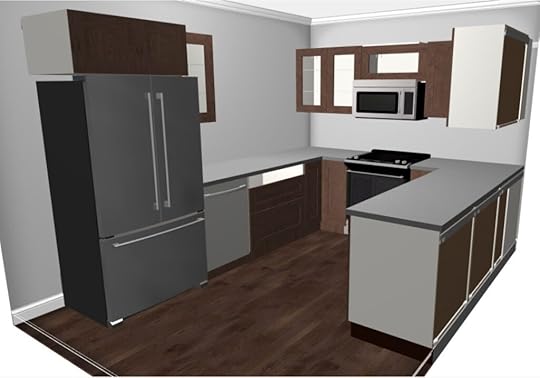 When I first saw this, I thought “WOW this is so different and so much better than my old kitchen!” Now, sure enough it simply looks like my actual kitchen and it’s even better than I had hoped.
When I first saw this, I thought “WOW this is so different and so much better than my old kitchen!” Now, sure enough it simply looks like my actual kitchen and it’s even better than I had hoped.3: Building new walls
In most cases, you’ll be removing more walls than you build, but sometimes you’ll need to add some as well. The most common situations for me are:
Moving an existing wall back to create more kitchen spaceCreating a “booth” of walls to enclose a refrigerator or build a food storage pantryBuilding the half wall (typical height is 34.5”) that eventually becomes an island.General principles:
It’s way easier to build a new wall than to mess around with too many changes to an old one. So I usually start with a complete demolition of any old walls, then proceed with a clean slate. If you’ve never learned how to frame a wall flat on the ground first, it’s a fun and life-changing skill! Here’s a 52-second summary on YouTube.3: Plumbing (and venting)
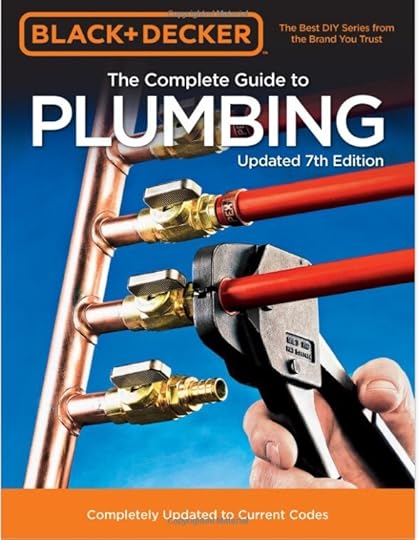
In many kitchen remodels, you end up leaving the plumbing fixtures (sink, dishwasher and fridge water line) in roughly the same place, and if so this part of the job is minimal.
But I also want to open your mind to the possibility that these things can be moved without too much trouble, and you can even create brand new ones whenever you need ‘em. While the finer points of code-compliant plumbing are best learned from the book or video of your choice, here are my favorite basic principles and useful shortcuts:
Cut back any obsolete copper plumbing and transition to PEX in a convenient location, which will make all your new work cleaner and easier. In a full house remodel, I usually do this right after the main house shutoff valve so the whole system can be built right from scratch.Sink drain lines are usually done with 1.5” black ABS (plastic) pipe which is quite easy to work with. If you’re doing a big project, grab a few ten-footers of the stuff up front as well as an assortment of fittings and the glue.Drain pipes should slope about ¼” per foot, and if you need to add a new air vent, consider a Studor vent, which saves you the pain of trying to connect your drain to a pipe that runs all the way through your roof. (I also like to minimize roof penetrations because it makes your eventual re-roofing job quicker and more reliable and leaves more room for solar panels)We’ll cover the sink, dishwasher and fridge plumbing separately below.
Related MMM Article from way back in 2012 (but recently updated):
How to Become a Kickass Plumber – with PEX
4: Electrical

Like plumbing, electricity is a whole trade in itself which is not comfortable for everyone. And you can indeed kill yourself if you touch live wires in the wrong way. So if in doubt, hire an electrician.
But since I happen to enjoy this trade myself, I made a point of learning the national electric code (currently called the 2020 NEC) enough to wire a few full houses from scratch and pass several final inspections: everything from digging the trench and running new buried service lines in conduit to the meter box, to subpanels and solar inverters down to the last light switch.
But I’m still not a professional electrician, and codes vary by region – so be sure to double check any ideas you get from me and do not assume anything you read is totally correct.
With all those disclaimers aside, here are the most common situations that come up when renovating a kitchen:
Unwanted electrical lines in a wall you are removing: I label these carefully, turn off the power, then pull everything out until I reach the nearest junction that’s in a wall I am keeping (or sometimes this will be in the ceiling or attic). Once the new walls are in place, you can run fresh wires to the new boxes and fixtures.
Adding new outlets to serve new countertop areas:
The basic requirement is a minimum of two 20 amp circuits, protected by GFCI outlets, with outlets at least every 4 feet along your work space. Plus, ideally the fridge, dishwasher, disposal and microwave are on their own separate circuits which is required in brand new builds. So, your project may be able to tie into the existing circuits or you may need to pull some new ones.
Adding entirely new circuits to your home:
Although this may sound like a black art to non-electricians, it’s actually quite straightforward once you learn how to do it. The hardest part is usually running the wire all the way back to your circuit panel, unless your kitchen is directly over an unfinished basement or crawlspace. So if you find an agreeable electrician willing to give you a discount in exchange for you doing the dirty work of properly routing the wire while they only do the final hookup in the panel, this can be a nice hybrid approach.
If you want to see the details of what’s involved in adding a whole new circuit and breaker to your panel, there are lots of walkthroughs on YouTube including this one I made myself on how to install your own electric car charger.
Other stuff to remember at this stage:
An outlet for your eventual over-the-range microwave (or just a wire if you are using a vent hood), centered about 78” above the floor so it is in the cabinet directly aboveA 4” steel vent pipe that goes from behind that microwave to somewhere outside your house (see your install manual for exact details)An outlet beneath the kitchen sink for the disposal, controlled by a wall switch at a safe distance nearbyPower for your dishwasher (I usually add a standard cord to my dishwasher so I can plug it in to this same outlet under the sink)Maybe even wiring for an outlet inside one of your cabinets, just behind the top drawer, for charging phones and other gadgets nicely out of sight5: Drywall and details
You’re finally ready to cover everything up! This part is relatively easy, but if you’ve never done drywall before, a few things I find helpful to get started:
Buy plenty of supplies (4×8 sheets, mesh tape, boxes of compound (mud), plus a trough and knife set) in advanceWhen installing sheets, use either a roto zip tool or a cordless “buzzer” multi tool to do the cutouts for your outlet boxes. Much better than manual hand saws or trying to do it with knives.As you open each box of mud, dispense it fully into a clean 5-gallon bucket with a lid. Fill up your trough periodically from this bucket. Never work directly from the box, or the bucket.I find that a light layer of spray adhesive before adding the mesh tape helps it stick much betterApply 2-3 coats of increasingly smooth mud before you bother with sanding (experienced drywallers typically only need to sand once at the end)This is the point – after drywall and at least a coat of primer or base white paint – where you would install your flooring if you are changing that out as part of the remodel. These days I’m a big fan of engineered wood or LVP flooring which is easy, tough and attractive. But for ultimate durability in a busy dogs-n-kids-n-giant parties household, floor tiles are still the gold standard.
6: Cabinets
Although this step is the most exciting part, it’s also one of the easiest. You’re just trying to put in a line of giant boxes as strong, straight and square as possible. For conventional cabinets, this means that a level and studfinder and shims are your best friends.
With IKEA cabinets, it’s even easier to get it right, because all of the cabinets (both upper and lower) just hang on their proprietary metal rail system. So if you get the rails right, the cabinets follow naturally. Another huge bonus: it’s easy to slide the cabinets back and forth and make adjustments before locking them into their final positions.
7: Countertops
If your budget will allow the higher cost, a stone countertop (quartz or granite or similar) is usually worth the cost. That cost is currently about $60-120 per square foot which can add up to a few grand for a large kitchen, but in exchange you get something that looks great, lasts forever and cleans up more easily than the other options.
Of course, that high cost (and my dislike of dealing with appointments and outside contractors) has meant that I have experimented with the other alternatives of solid wood and various types of tiles on some projects. They still look nice and function pretty well, but I have always regretted the choice in the long run and wished I had done the quartz. Possibly because of the human psychology factor: a small daily annoyance of worrying about scratching your wood countertop is with you forever. Whereas a one-time expense for the stone countertops quickly recedes into history and you forget about it. And like the rest of a kitchen upgrade, it tends to come back to you in the form of increased resale or rental value anyway.
8: Sink and Faucet
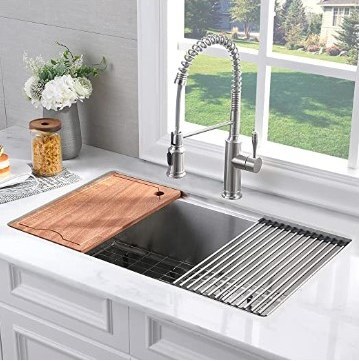
Thankfully, this part is the opposite of the countertops: surprisingly cheap and full of beautiful options depending on your taste.
Way back in 2001, I remember paying $600 for a sink and $300 for a faucet, just to get something substantial and modern that didn’t look like it was from a 1980s Atlanta Georgia suburb (an aesthetic that runs strong in Home Depot products because of the company’s origins in that time and place).
But now, thanks to Amazon we live in a whole different world. You can have your choice of massive, modern sinks in the 200s, and even beautiful faucets are under $100. The prices are sometimes so low that I am nervous about the quality, but so far everything has been a pleasant surprise on the upside. TBD sink drain pic above.
Bonus: How to build a nice new sink drain:
Your old kitchen probably has an ugly nest of pipes under the kitchen sink, and you’ll at least need to rework this part because the new sink will be bigger and in a slightly different place. So we might as well cover this right here:
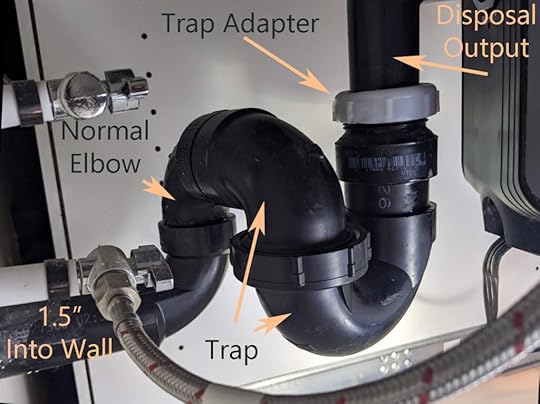 CORRECTION! (new pic TBD) – a reader pointed out that the “normal elbow” technically should not be there – I should have mounted this trap lower so the trap connects at the same level as the wall pipe. But that would be a shame since then the trap would block the drawer. The solution? Build your wall plumbing higher so it’s right where you want the trap output to be.
CORRECTION! (new pic TBD) – a reader pointed out that the “normal elbow” technically should not be there – I should have mounted this trap lower so the trap connects at the same level as the wall pipe. But that would be a shame since then the trap would block the drawer. The solution? Build your wall plumbing higher so it’s right where you want the trap output to be.Starting with the fancy new sink (which comes right after countertops), you
Install the disposal unit which doubles as the drain as wellLoose-fit a trap adapter to the disposal output and then figure out what direction to angle your trap to create the simplest/tidiest run to the wall pipeAdd elbows and straight bits as needed to get the water to that final destinationOnce you are sure everything fits, mark the joints with tape or a marker, then carefully disassemble, glue, and reassemble/tighten everything. Ready for water within an hour!9: Appliances
This is yet another area where we’ve seen deflation over the years rather than inflation: the quality and features of appliances seems to keep going up, while prices come down. And the used market is even better: appliances have a very low resale value, which means if you shop carefully you can get new-ish units for about 75% less than brand-new ones.
However, a note of caution: Don’t buy used stuff unless you trust the seller and/or get a chance to test it. I’ve been fooled twice buying used seemingly high-end dishwashers that seemed great … but in retrospect the person was selling them because they didn’t work properly.
Me: “Wow, this is a really nice $1500 dishwasher – why are you selling it?”
Seller: “Oh… I was upgrading my kitchen and this one just doesn’t match the new appliances.”
Me: (naively overlooking some other red flags about the seller’s living situation): “Okay here’s my $200 in cash.”
On a third occasion, a friend and I almost made the same mistake when buying an exotic under-counter European fridge, but thankfully noticed that the seller had it sitting in his garage unplugged when we came to pick it up. When I asked to see it running, he pretended to have a shortage of extension cords so I pulled one out of my van. Sure enough, when we plugged it in, the damned thing wasn’t even working. Shady!
Other tips: fridges, microwaves and especially ovens/ranges are a safer bet to buy used because they tend to just work for decades.
Also, if you live in a climate with sub-freezing winters, don’t buy a fridge, dishwasher or washing machine that someone has moved into their shed or garage during the cold season. Because the water in the tubes and valves will probably have frozen and burst without their knowledge, giving you a messy and complex repair job the first time you fire it up.
Because of all this, I have had many success stories with used appliances in the past, but I still tend to buy all new appliances these days now that time has become more scarce than money for me. If you’re younger and still trying to optimize for dollars, you should still check Craigslist and Facebook Marketplace regularly.
10: Finish work!
 Despite the very small kitchen, this house in my neighborhood recently sold for a preposterously high price, mainly because of nice touches like this full height backsplash. When renovating, more tiles are usually better.
Despite the very small kitchen, this house in my neighborhood recently sold for a preposterously high price, mainly because of nice touches like this full height backsplash. When renovating, more tiles are usually better.At last, we’re in the home stretch. You can add as many custom flourishes to your kitchen as you like, but just to share a few of my favorites:
An artsy tile backsplash is a great way to make any kitchen way more interesting. I like to tile the entire area from the countertop up to the upper cabinets. In some cases on empty walls, I’ve gone all the way up to the ceiling to create an even bigger feeling of space.Consider hiding a power cord inside a top drawer somewhere, which you can then hook up to a nice multi port USB charger, so you can keep all of the phones, tablets, bike lights out of your precious work area.Stainless steel outlet plates and modern-style grey outlets and switches add a more polished and high-quality look to any area, especially kitchens.Undercabinet lights are worth the effort, as they provide great illumination while cooking and make for beautiful ambience even hosting parties or dinners.Wow, that was a Lot!
This may be the longest MMM article in history, and yet we still only skimmed through it. But I hope this summary gives you at least a peek at the countless fun, useful and profitable skills that you can learn to make your life as a homeowner (or as an occasional contractor) more joyful and satisfying.
If you have more questions about specifics, drop them into the comments section below and everyone can help share some answers. And of course, this article will surely be full of errors and omissions when I first publish it – please feel free to point those out and I’ll make updates as well.
Happy cooking!
December 10, 2022
The California Effect
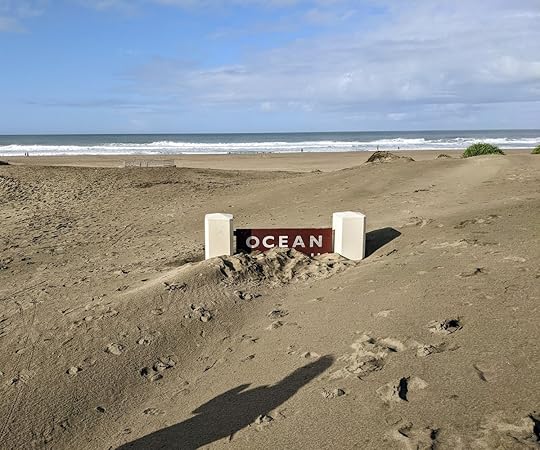

One of the reasons I don’t write as often these days is that my life has gradually evolved into a Personal Finance Bubble.
The people around me have learned to be purposeful with their money, which means they now have plenty of savings and never have to stress about the stuff. Good ideas have naturally spread between the old group of friends, and new ones with similar values have drifted in over the years.
And it has happened so much that that it’s almost normal for everyone in the neighborhood to have their own CNBC Make It feature*, which they don’t even get around to mentioning because we’re too busy helping each other with bathroom renovations or sharing the latest golden scores from Craigslist.
Because this is my everyday reality, I have mistakenly come to assume that this must be normal, and that perhaps these ideas of Mustachian living have just become universal out there in American life. Job well done MMM, time to hang up the keyboard and retire!
Until last weekend, when I took a short trip out to San Francisco and plunged deep into the astonishing reality of life outside of this bubble. And I realized that wow, we still have so much work to do. And there is so much that both sides – the Ultraconsumers and the Mustachians – can learn about human nature by studying the differences in our lifestyles.
 A recent “winter” day at the Bay
A recent “winter” day at the BayThe city of San Francisco is often called “The City” by locals, but it’s really part of a megalopolis known as “The Bay Area”. Both of these nicknames are somewhat telling because they imply that there is only ONE bay and ONE city on the planet, and thus those embody the social and spending norms to which we should all comply.
To outsiders like the rest of us, The Bay Area is a bizarre and wild human science laboratory, in which our most beautiful and most ridiculous traits are simultaneously revealed. Artificial boundaries aside, in reality it’s all one teeming urban area which sprawls across ten thousand square miles and houses eight million people in an incredibly wide range of conditions.
The median house price is about $1.5 million, but that figure masks even more amazing differences because it includes “bad” neighborhoods where you can get in as low as $750k as long as you don’t mind a long commute and/or trash-strewn streets and keeping your house locked behind a steel gate at all times. And nicer ones with where the prices start around $3M.
Locals have become accustomed to $6.00 gasoline over the past year, $7.00 slices of pizza at a grungy restaurant if you shop around, and similarly surprising prices on most other services. One new homeowner lamented the $90-per-hour rate that his housekeeping company was now charging him to clean the house, and I enjoyed the opportunity to pick up a brunch tab for three ($148 including tip) on a nice sunny patio at a modest restaurant. A young single professional in the finance industry asked me whether he should downsize to just one seven-passenger Mercedes SUV to escape the second $1200 per month car payment from his monthly expenses (and free up a $200 parking space to boot).
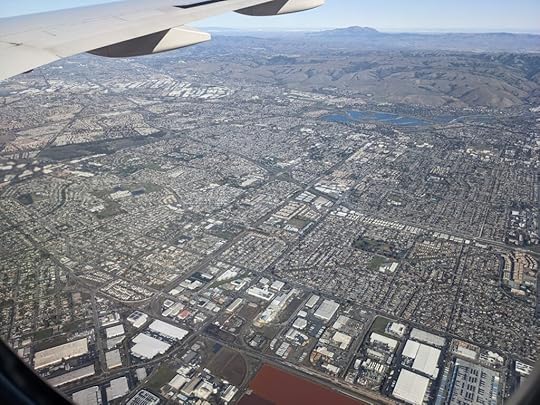
With stories like these, it’s easy for the average person to just fall in line and repeat the standard Bay Area lament:
“This is just a high cost of living area so it’s impossible to get ahead”
But as my visit progressed and I looked in with my usual outsider’s perspective, I couldn’t help but notice an awful lot of holes in this argument.
Just as I do at home, I spent the majority of my leisure time with good friends, exploring beautiful parks and neighborhoods on foot. Sometimes we walked just to get to our appointments and meetings, arriving to hear stories about how bad the car traffic was or how late and expensive the Uber ride had been for the other attendees. Interesting.
Other times we hiked purposefully along cliffs and ocean shores. These days of fresh air and tens of thousands of steps left us feeling lean and healthy, with endless happy memories, enormous appetites and legs of sculpted steel. And yet they somehow cost absolutely nothing. And then we’d run into somebody who mentioned how hard it was to find time to get in shape, or how impractical it was to walk or ride a bike in a city with such steep hills. Curious.
We shopped in local grocery stores and I checked in on Costco prices in the area, and I noticed that despite the high cost of almost everything else, actual food was only a few percent more expensive than it is in the affordable middle of the country where I live. Strange.
On top of this, Northern California happens to be blessed with a climate where the leaves and flowers bloom year-round (often hanging low with free fruits and vegetables), you rarely need heating or air conditioning for your home, and bike transportation is easy year-round because you’ll never encounter conditions more challenging than a bit of mildly cool rain or mist.

Where I grew up in Canada, people would cry tears of joy if they woke up in January to discover the streets were free from snow and shimmering with actual liquid water. We would don our swimsuits and spend the day dancing in the streets in a spontaneous block party.
But in California, everybody dodges even the slightest weather, drives cars even though they are the slowest and most expensive way to get around, eats most of their meals at restaurants, considers a $150 bottle of wine to be a reasonable indulgence on a Friday, lives far away from work and signs up for activities that are far away from home. Which means that despite the area’s nation-leading salaries, the average person is no further ahead than the rest of us.
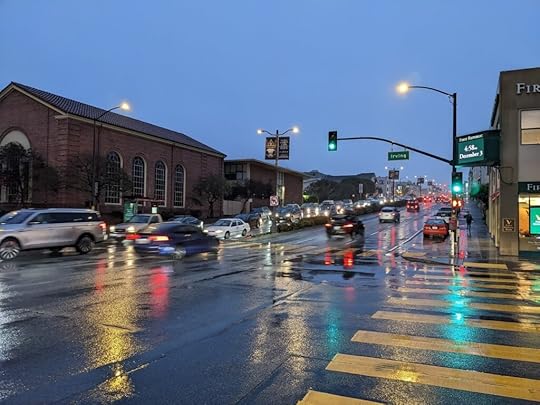
On the grander scale, the California government is a supersized example of its spendy populace: they just keep building more titanic roads and cathedral-like networks of overlapping arched bridges and ocean-sized parking lots. All to subsidize and disguise the preposterous use of the massive, stupid, personal racing lounges that people call “cars”, which they think they need because they haven’t stopped to consider how ridiculous the whole situation is. The cars and roads ruin the vast majority of their beautiful land, turning everything into a screaming, crashing, toxic din of expensive and purely unnecessary bullshit.
Of course, all that driving causes thousands of violent deaths due to crashes, and requires hundreds of thousands of police officers, ambulances, and fire trucks to patrol. The sedentary lifestyle and the body destroying nature of sitting down in a car for several hours per day causes millions of early deaths due to heart disease and diabetes and related conditions, which requires hundreds of additional hospitals and thousands of doctors and surgeons to mop up the carnage. And they pay for it all with some of the nation’s highest tax rates.
Then the people blow the rest of their income on buying even more expensive cars and gasoline to race around on the unnecessary trillion-dollar road network.
So yeah, that’s the California effect. But lest you think I’m beating up unfairly on the people of this fine state, it’s really just a magnified version of the Everywhere Effect. It is an astonishing wasted opportunity for the growing billions of people who are trapped in and perpetuating the illogical and self-defeating systems of our modern rich world.
But if you think of it from the opposite perspective, it is simultaneously the biggest life opportunity in human history: the understanding that all of us live in a bubble which we incorrectly perceive as “normal”.
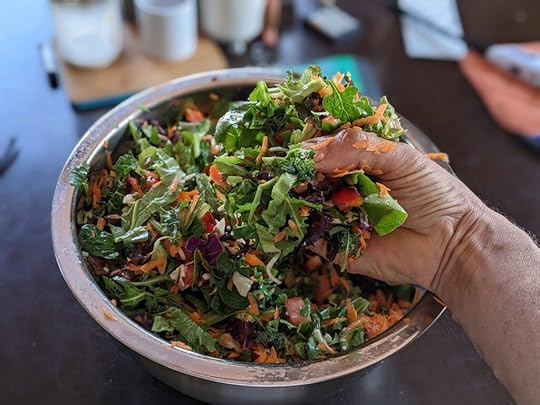
Mr. Money Mustache lives on a quiet street where where millionaire early retirees still prefer old cars and do our own housework, and we think that is normal.
San Francisco professionals live in a place where 25-year-old tech workers enjoy $200,000 starting salaries, yet still have credit card debt and car loans, and they think that is normal.
In a recent podcast episode, the researcher Lex Fridman described his experience interviewing Ukrainian people in the occupied war zones of that country, asking them if they felt it was safe where they lived. They generally said it was, despite frequent bombings and the occasional deaths of friends and family members. They have already started feeling that even war is normal.
From TV addicts who binge watch for five hours per day, to ultra endurance athletes like Tony Riddel who sometimes runs two marathons per day for nine consecutive days (mostly in bare feet), to alcoholics who can consume 30 beers before lunch time, to video gamers and bluegrass banjo players and olympic gymnasts with unimaginably fast neural circuitry and muscular control, it’s all the same thing: when a human brain experiences a stimulus, it quickly rewires and adapts and starts to think:
“This is normal.“
The ultimate lesson, then, is to remind yourself that no, your current life is not normal.
It’s super weird and super specific, and you can completely change the damned thing in as many ways as you like and you absolutely will adapt and be able to handle it.
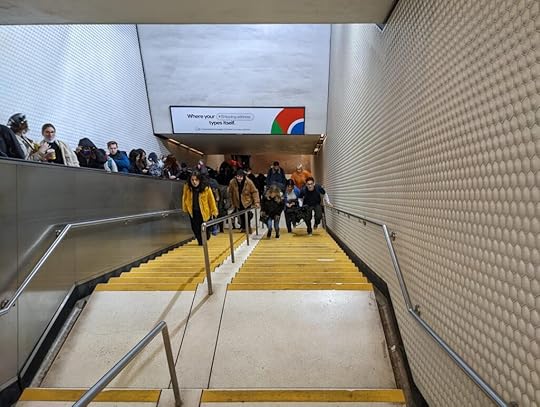 There was a huge line for the escalator but the 5-storey staircase was wide open. So of course I took the stairs. Then turned back and was happy to see people had started following my example once they saw it was “normal”
There was a huge line for the escalator but the 5-storey staircase was wide open. So of course I took the stairs. Then turned back and was happy to see people had started following my example once they saw it was “normal”The cool part about this is, it means if you put the right things into your life (health, fitness, sensible spending, learning, socializing, and helping people), you’ll get used to those just as quickly as everyone else adapts to screen time and sodas and car loans.
Your Assignment:
Write a list of everything in your life that is expensive, bad for your physical or mental health, or both.
Consider how normal these things feel to you, but then imagine a totally different person, who is happy and successful self-actualized, who does not have or need these things in their life. Interesting. How do they do it?
Start noticing your own bubble, and study the California Effect in your own lifestyle. Where do you see ridiculousness masquerading as normalcy? How can you extract the best of life in your area, while shedding the unnecessary downsides?
How can you create an entirely new bubble of normal, that serves you better?
That simple mindset is the underlying backbone of not just Financial Independence, but the best possible life all around.
 Oceanfront views and leg sculpting classes – FREE!
Oceanfront views and leg sculpting classes – FREE!Super Special Note:
The MMM Boot Camp Email Series is Finally Ready!
I spent most of the past year combing through this blog’s 500+ posts, picking out the best 52, polishing them up, and arranging them into a weekly series
… which you can now join for FREE, right here with this link.
No spam or salesy stuff because I have nothing to sell. Just a year of gradual, pleasant lifestyle transformation delivered right to your inbox.
* congrats Amberly and John! Their CNBC story is available here – I recommend the written version as it has more accurate details than the video.
In the Comments: What changes do you struggle with? Things you know would be good for you but seem “too hard”. Are they things that would be outside of the social norm for your area and peer group?
September 30, 2022
Lessons From the Badass Muscular Neurobiologist


Have you ever noticed that as a whole, our society has its daily habits almost completely backwards?
We’re generally so “busy” that we don’t have time to get much exercise. And then we spend countless sedentary hours sitting in our cars each week because we think that car driving saves us time.
To fuel our bodies during these chaotic days, we pack ourselves with whatever convenient or tasty food we happen to crave at the moment, then add in additional snacks between meals, while watching TV, and perhaps a final treat before bed.
In any leftover shreds of free time, we pack our minds with similarly tasty or convenient blobs of entertainment or “content” that happen to successfully push their way in front of our face like a pen full of hungry pigs fighting for the scraps of our attention.
And our food factories, magazines, newspapers, TV and streaming services and even politicians are only too happy to keep pushing out the crap. And the results are just as you would predict: crappy.
But there is some good news too: You can do everything in the opposite way, and the results tend to be astonishingly good. The biggest difference you’ll notice is dramatically better physical and mental health, which multiply together to create a better, happier, longer and more generous life in all dimensions.
In other words if there’s anything worth striving for – even more than financial independence or early retirement or any other individual goals – it’s probably the overall package of a healthier you.
Over the past few months, I have found myself settling into a new routine that seems to be getting better and better as the positive results feed back onto themselves. It has become so good that I thought it would be worth sharing and comparing notes with you.
To cut straight to the good part, let’s compare the flow of two hypothetical days, side-by-side: the typical American default life, and a somewhat optimized Science-backed Life. Then, we’ll go back and fill in the details on where all these details come from, and the reason for this blog post’s strange title.
Default LifestyleSCIENCE Lifestyle• Wake up with alarm clock, roll over, and immediately check phone.• Wake up naturally as your sleep cycle ends.
• Proceed directly outside into the natural light.
• Direct your vision upwards and also try to get sunlight on your skin if possible.• Make coffee and a high-carb, high-sugar breakfast like toast, orange juice, waffles, flavored yogurt, etc.• Go for a short walk (or even run) depending on your fitness level.
• Then return and have a light breakfast (coffee or tea, nuts, an omelet if you’re hungry)• Scroll some Facebook/Twitter on your phone and/or turn on the TV news to “stay informed”• Grab your pen and a paper journal and write out your thoughts for the day: things you are grateful for, things you are excited about today, and a list of top priorities for the day.• Get into your car and drive to work• Walk or bike to the office, or settle into a dedicated space in your home to begin work.• Endure the usual frenzy of firefighting, distractions and occasional entertainment as you try to get your job done.• Turn off your phone and disable email for 1-3 hour periods when producing creative new stuff (make sure your colleagues know this is how you operate).
• Come out of this focus mode for batch email responses and any meetings, then return for a second session in the afternoon.• Drive through heavy suburban traffic to a restaurant for lunch, eat some processed foods and a soft drink and/or beer.• Go for a walk at lunch, then eat a giant salad with optional added protein sources.• Finish work and drive home, flip on the TV and Doordash something for dinner.• Finish work and walk home.
• Stop by the gym (whether at a facility or at home) for a brief session of heavy weight training
• This could be as little as six sets of lifts with under two minutes of rest between the sets.• Have a beer or wine with dinner, which may turn into a second if it’s tasting good (or one of those 12+ ounce wine glasses).
Benders on Weekends!• Avoid casual alcohol consumption.
• If you do enjoy the drug, save it for true special occasions – a maximum of 2-3 drinks over the course of a week.• Head back to the couch to finish off the day with some favorite shows
• Or, relax with the phone or laptop to finish off the night with some Facebook, Tiktok, Instagram, Reddit, YouTube or whatever else strikes your fancy.• All devices are off after about 7:30pm except for things you plan purposefully (family movie, date night, etc).
• This will open up an incredible void which you’ll suddenly find yourself filling with catching up on personal development, taking care of the house, setting yourself up for tomorrow, reading, meditation listening to podcasts, and journaling.
• AND, you’ll get tired and fall asleep much easier, allowing you to begin the cycle anew tomorrow without the need for an alarm clock.General Principles:
• Throughout your days, seek comfort and convenience.
• Keep your air conditioning set down at 72 in summer, your heat at 70 in winter, and avoid exposure to heat, cool, discomfort, hardship or exertion whenever possible.
• Focus on your limitations and the fact that the outside world is at fault for where you are in life. General Principles:
• Find ways to seek voluntary hardship rather than avoiding it.
• Challenge your limits by walking in hot and cold weather, enduring a hot sauna, pools or lakes or streams of very cold water, and always identifying and stretching your limits in all dimensions.
• Focus on learning. Every “problem” in life is really just a sign that you have more to learn.
So What is This All About?
If you didn’t recognize the man in the picture above, these ideas have been meticulously stacked into my head by Dr. Andrew Huberman, the Stanford professor of Neurobiology and Ophthalmology who has now also risen to the top of the podcasting field.
The basic information is only partially new – Huberman covers almost every aspect of the brain and body, and the field of science has been working on some of this stuff for a long time. But the rate of progress is faster than ever, so he has become my trained guide to filter and pass on the most useful findings, in an accessible and engaging style. I find the episodes thorough, detailed, and relentlessly focused on actual science instead of just speculation.
The packaging is important to me too. I’ve been a health and fitness enthusiast since I was sixteen, but until now the field always had an uncomfortable split down the middle: there were the glossy and buff promoters – mostly salespeople for their own products with very little substance (and an inherent conflict of interest). And then there were the actual scientists, lacking in style and presentation skills and often sporting unenviable physical forms as well, making them less inspiring to follow even before the fact that they typically communicate mostly in the form of academic papers.
Huberman unites both personas into one – he’s a real scientist, but also a great presenter. And every time he shoots another two hour Laser Beam of Focus from his intensely intelligent eyes through the screen directly into yours, while gesturing precisely with that highly athletic form packed into a classy black dress shirt, it’s a lot easier to convince yourself that “Hey, this is probably pretty good advice if it will make me even a bit more like this guy*.”
The Molecule of More
It all started when a friend sent me a link to this episode on ADHD, knowing it’s something I am always trying to optimize my life around. It immediately revolutionized my understanding of how my own brain works, which led me to this episode on depression, and this one on Dopamine and its effect on our motivation and drive.
Everything started to fall into place as I learned about the role of brain chemicals in general, but specifically the effects of Dopamine and Adrenaline on my own life. As it turns out, the flow of these molecules dictate not only my classic ADHD symptoms of difficulty focusing and remembering where I put things, but also my ability to feel happy, feel like making plans, and feel like doing anything at all. Which helped me understand why days with strong “ADHD” symptoms can also feel like depression symptoms.

This led me to an entire side journey into Dopamine research, as I followed Huberman’s recommendation to read a book called The Molecule of More, which turned out to be a life-changing experience on its own. Not only does the book peel away some of the biggest mysteries of Human nature and leave you with a new level of understanding of why we feel and act the way we do, but it also has a compelling flow that’s much closer to a thriller novel than a science book.
I learned that while Dopamine is often labeled as the molecule of pleasure, this characterization is not quite accurate. In reality, it’s the molecule of motivation – the substance that causes us to be interested and take actions towards something that our mind expects to bring us pleasure (which in turn usually means food, mating or social benefits). But the actual attainment of that pleasure tends to temporarily quench our desire and decrease motivation.
Until our brain comes up with the next thing we don’t currently have, which triggers more dopamine, more motivation, and more seeking. Which can either lead to good things like healthy living and self-actualization, or addictions to drugs, success and status for its own sake, or the hedonic treadmill we talk about so much here in the personal finance world.
Applying this knowledge to my own life: ADHD is a condition which often comes with suppressed dopamine levels. When in this state, we sufferers have trouble with things like maintaining focus, keeping track of objects in the physical world or remembering names and faces, and making future plans. Some of us compensate with hyperactive and impulsive novelty-seeking behaviors, unconsciously seeking things that trigger more dopamine release. But for others like me it manifests as a mildly depressive state – turning away from the outside world and focusing on things that are more familiar and require less planning.
By doing more of the things that help release and stabilize my dopamine levels (basically everything in the table above), I was able to start feeling more consistently energized and motivated, which gave me even more ability to keep the good routines going, and so on. It has become a virtuous circle that has me exercising more, sleeping better, eating better, seeing positive physical changes, saying “yes” to more plans with more people, and getting more done with my days.
70 Hours of Speed Learning
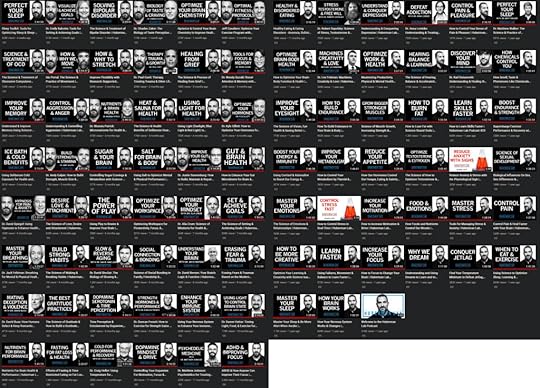 Here’ my “Huberman Report Card” so far. Each one of these red bars represents about 80 minutes of concentrated learning time, even when listening at an accelerated pace. This is how much I am drawn to this material (which means even more in my case because I’m easily bored by anything but the most interesting stuff!)
Here’ my “Huberman Report Card” so far. Each one of these red bars represents about 80 minutes of concentrated learning time, even when listening at an accelerated pace. This is how much I am drawn to this material (which means even more in my case because I’m easily bored by anything but the most interesting stuff!)So I kept listening to more and more of his episodes. And as the knowledge flowed in, I started noticing the overlapping patterns in every area of health. It all seems to boil down to the same few things.
Exercise (especially outdoors plus lifting heavy things) Nutrition Mindfulness and Meditation-style breaksSleepThese things in turn affect the plumbing and the hormones in both our bodies and brains, which in turn controls EVERYTHING – from mood and energy to body composition to the immune system and even our chances of chronic diseases – including cancer.
It sounds somewhat obvious, but I think the key is understanding this stuff down to the deepest fibers of your soul: everything affects everything. So if you want a better life, take care of every part of yourself, by making the entirety of your day something that improves you, rather than wears you down.
You don’t have to be perfect, of course. But you do have to understand which stuff is good for you, which is neutral, and which is counterproductive. At that moment, a little Scientist Angel will materialize on your shoulder and start advising you on every decision. And it will just naturally become easier to make positive choices. And when you do decide to be decadent and naughty, it will be a deliberate conscious and fun choice, which you will do in moderation.
Call To Action
The best way to live life is to combine a constant appreciation of the present moment, with a general program of consistent improvement. That way, you get to feel good about both the present and the future.
So if you’re up for the challenge, I’d love to see both of us – you and me – continue to iron out our daily routines so they bring us both more moments of feeling great and more decades of personal growth. That means doing our best to learn something new every day, and do something hard every day.
And if you’re looking for somewhere specific to start, I think that taking a long walk with a great podcast is one of the most simple yet powerful options.
Listening Tips:
I typically enjoy listening to podcasts and audio books with the playback speed set to 1.5x, which helps make them more engaging (it gives my easily distracted brain less time to wander because the information flow is faster plus it saves a lot of time). It’s definitely worth experimenting with speeds if you have never done so before.
The next revolution for me was switching from standard headphones to good quality wireless earbuds* so I can combine the learning with my long daily walks, workouts, carpentry and chores around the house. The better models even have good microphones built in so you can use them for phone calls and meetings.
Finally, many of these podcasts have a long “sponsors” section built in which can be a chore to listen to more than once. On the YouTube app on your phone, you can do a two-finger double-tap on the right side of the screen to immediately jump through this section and get to the good stuff. Other media and podcast players have similar things, or at the very minimum a double-tap feature to jump ahead 10 seconds.
Bonus Technique: Successful Transformation through a Madwoman’s Scribblings

As I was writing this article, I happened to reconnect with a longtime friend who revealed that she too had made some great progress in feeling better and improving her health and fitness after a rough patch in life. Her secret to success was revealed in the strange photograph at left.
The idea is that you put your ideal daily activities down the left hand side of a page, and the days of an entire month along the top, and stick this thing on your fridge. Then you color in the squares for each day as you achieve each activity.
You probably won’t get them all, but every square counts. And because this chart is right in your face every time you visit your kitchen, you are reminded and motivated to get as many as possible. Easy accountability, and you can just keep it going and making adjustments for month after month. I just printed out my first one today!
Shortcut: Here’s a first version of a Badassity Tracker chart I made for myself:
—
In the Comments: What habits and self-inflicted problems do you struggle with the most? And if you feel you’re doing well at something, what has been the cause of that success? I’d love to see more people working and sharing with their peer groups, to make healthy self-improvement much more of a national pastime.
* Superstar Scientists: An article like this would not be complete without also mentioning Peter Attia, an equally prolific researcher, doctor and educator who has also pulled me in to dozens of hours of his teachings on health, medicine and longevity. For best results, I recommend following any and all of these types of people – as long as they seek and present real science, choose whoever inspires you the most.
** Wireless earbuds – if you’re looking for a research shortcut, I’ve been using this Anker Liberty Air 2 Pro set (affiliate link) for about 6 hours every single day for the last year. Here’s another similar option, on sale at the time of writing. Insanely good yet cheap which makes you wonder why the hell Apple airpods cost so much (!?). And they were transformative for me because the noise canceling feature eliminates not only airplane noise during flights, but all the engine noise of urban life, making walks much more pleasant.
September 6, 2022
It’s Get Smart With Money Day!
Let’s jump right to the real news here:
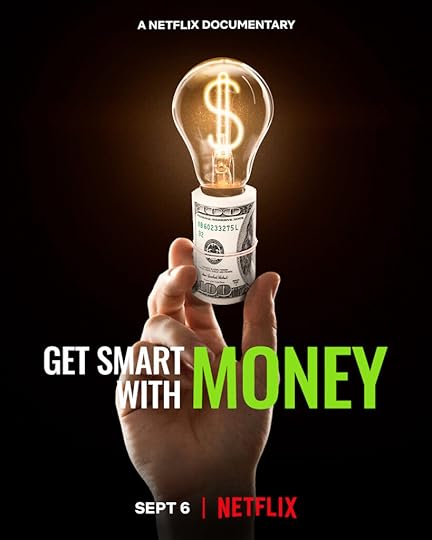 There’s a Netflix documentary that just came out TODAY* called Get Smart With MoneySomehow old Mr. Money Mustache and several friends got lured into playing a role in making it. And I’m very happy with the results!And you can watch the results here (which will be a huge help to the movie’s success!):
https://www.netflix.com/title/81312877
There’s a Netflix documentary that just came out TODAY* called Get Smart With MoneySomehow old Mr. Money Mustache and several friends got lured into playing a role in making it. And I’m very happy with the results!And you can watch the results here (which will be a huge help to the movie’s success!):
https://www.netflix.com/title/81312877
Now for the real story behind this weird situation. Why did I agree to this? Aren’t I supposed to be retired? Do you get paid a lot to be in a Netflix movie? And does that mean you become “famous” and your life changes? Read on to find these answers and more.
The Origin
One sunny afternoon in December 2020, I got an email from the co-owner of a filmmaking company with this title:
Feature Documentary – personal finance
Inside was a very well written description of her idea for a movie, and a heartfelt invitation for me to be one of the people featured in it.
I immediately went through my usual series of reactions: Feeling flattered that someone would actually want me in their production. Then dread at the idea of actually signing myself up for a bunch of “work” when I’m already way too busy doing fun, meaningful stuff as a retired person. Then a motivated excitement to write back immediately to say,
“Thanks so much, I’m honored, but no thanks, and good luck and maybe I could help out by email just as a casual consultant if you need any ideas.”
Well, that failed. Because this filmmaker turned out to be Kristin Lazure, who then pulled her co-founder Stephanie Soechtig into the conversation, and together they run Atlas Films, not just another documentary company but one of the best ones in the country.
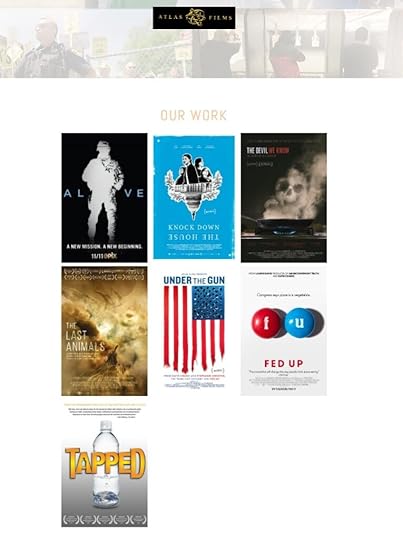
Atlas has made super-incisive films on food, public health, guns, political cover-ups and so many more things, all of them watchable and action-oriented. As I watched their earlier titles, I realized that Atlas does not exist just to crank out entertainment or profit from cheap controversy. They are willing to do the real work to dig out the real stories, with the goal of creating positive social change.
“Shit”, I thought. “How can I say no to this, if my goal with this MMM hobby is really to try to make a difference myself?”
I realized that sure, doing screen and camera work is hard and sometimes inconvenient and it would suck away some of the time I would normally put into writing blog articles. But in exchange it would almost certainly reach a lot more people for each hour I invested into it, and equally important it would reach new people, Netflix watchers who are probably a different group than blog readers.
And, if you set aside my serious-eyebrows-pretend-grownup charade of being all concerned and logical, I also thought it would be a lot of fun to be part of such a big, exciting, new experience. And shit man, how neat to be able to go over to a friend’s house and dare them to put on YOUR OWN NETFLIX MOVIE!?!
So I said yes, and the giant ball started rolling really fast, and suddenly we spent the entire 2021 hopping through a series of occasional filming days, and recorded zoom calls, and other silly, interesting experiences.

Some of it was indeed hard (like being squeezed onto my deck along with a dozen production crew in the full blazing solar onslaught of a July afternoon, pretending to act natural while answering interview questions, pausing only to wipe away the occasional gallon of sweat from my forehead.) But almost all of it was loads of fun. And it led to wonderful new experiences and friendships for all of us.
One thing you’ll notice if you watch the movie, is that I talk a big game about how hard this all was, yet in the movie I just seem to pop in occasionally, do a couple of bike tricks and play with power tools, and oh yeah sometimes drop a few sagely financial one-liners to help my students along the way. This is because our content was edited down by probably a 100:1 ratio. They cover a lot of ground in this movie with a lot of people, and yet somehow it all feels natural and coherent.
My favorite part is probably that my old concept of the “Purchase Justification Machine”, first described in this 2019 article about me not buying a Tesla, made it into the movie in the form of a glorious and silly on-screen animated graphic – grinding away at Kim as she browses Amazon while riding her Peloton.
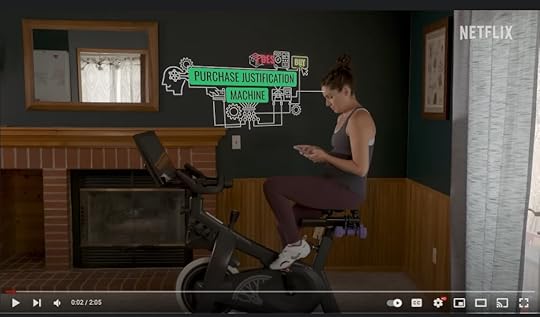
Money and Fame
Oh, and no, we didn’t get paid much at all, especially if you work it out on an hourly basis. Documentaries like this have a high production budget when it comes to top-quality crew and equipment, but they somehow manage to get us on-camera participants to willingly almost donate our time.
If you value fame or exposure, that alone could be considered a valuable form of payment. But in my case, any added fame would be a downside – there are very few real-world benefits and quite a few downsides related to privacy, which in extreme situations can even lead to danger. However I figured I’m just one of many people in this movie, and it’s a small fish relative to the overall ocean of Netflix. When I weighed that against the benefits of sharing better financial and lifestyle habits, I took an optimistic guess and decided that the good aspects outweighed the bad. I’ll let you know how this goes now that the movie is out!
So What’s The Movie About?
Atlas films rounded up four financial gurus, all of us with different backgrounds and styles (Paula Pant, Tiffany Aliche, Ro$$ Mac, and myself.)
Then they had us send “casting calls” out to the Internet, summoning our ideal students with the offer of a year of free coaching – in exchange for it all being filmed and shared with the world.
Surprisingly, we got loads of responses – in the form of personal video stories from singles, couples and families, all of them charming and heartfelt and leaving me wishing I had time to welcome and try to help all of them.
In the end, I chose a young family of four that falls into the same demographic to which I target these blog posts: people with high incomes and high spending, who are wondering where all the money is going.
I taught my couple, John and Kim, how to streamline their initial $12,000+ per month spending budget (!!), through things like more efficient grocery shopping and dining, keeping a closer eye on impulse purchasing, thinking about housing and neighborhoods and school choices (private versus public), and whether to consider side income streams over the longer run to allow them to scale back on work.
As you’ll see in the movie, the end results were both subtle and dramatic at the same time. And I’m happy to report that these subjects are now real-life friends and even live nearby so we get to enjoy the results of their more fun new lifestyle together.
So, I hope you enjoy both the movie and the backstory. I’m very happy that I said “yes” after all, even though I can guarantee that I won’t be coming back for a sequel or an ongoing series. The camera vans have long since left and my schedule is back to its normal blissfully open state.
With this little report to you now wrapping up, it’s back to my construction projects here at the house for the rest of this week, then off for some camping deep in the mountains this weekend. Seventeen years in, this version of retirement remains the right life for me.
And I wish you your own version of living the dream this week as well!
—–
*September 6th, 2022
In the Comments: Did you watch the movie? If so what did you think? How could it have been made even better if you were doing the cuts?
My candid criticism, being a details person, is that they tried to cover so much that they didn’t have much time for the details. But then again, you can’t teach all the details of such a broad subject with just a documentary, while also keeping it fun to watch. So I’m hoping that the easy breezy approachable nature of the movie leads people to start thinking about these things on their own. Once the right seed is planted, better money habits can catch on pretty easily.
July 18, 2022
Why You’ll Probably Never Run Out Of Money
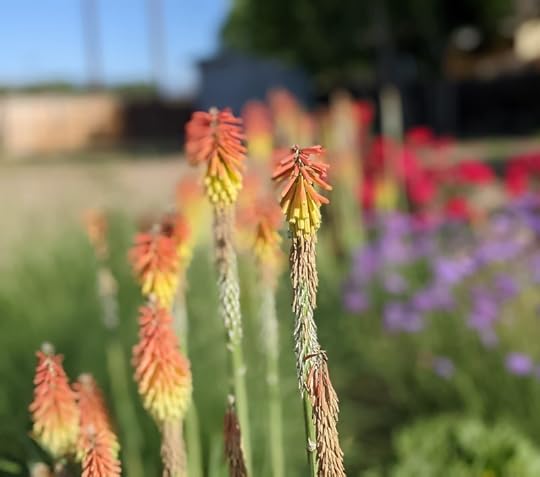

As strange as it may sound, earning financial freedom is a lot easier for certain people than claiming that freedom once they have earned it. And if the following statement rings true to you, you may be suffering from this same hardship:
“I think I’m close to having enough money to jump into early retirement, but not quite.
So I’m just working one more year and starting one more side hustle and buckling down extra hard to be more certain.”
It sounds rational, right? After all, you can never be too careful, as the saying goes.
But the problem is that these people keep repeating the mantra regardless of how much money they have, and regardless of their actual living expenses. No matter how bright their financial picture is, they always find a way to undervalue their savings and overestimate their future expenses, just in case of the unexpected.
And by tilting the balance ever further in the direction of “safety”, they forget about what should be on the other side of the scale, which is “making the most of your finite time on this lovely planet.”
This happens way more than you might think. Every week, it’s in my email inbox and my in-person conversations with people I meet. This fear is even prevalent among some of my real-life friends, so let’s look at a couple of thinly disguised examples from that group to see some of the symptoms (and a possible cure for) this famed affliction of One More Year Syndrome.
Alina’s Anemic Withdrawal Rate
Alina is a currently-single doctor in a stressful but well paid area of practice, age 50 with one grown child. She has about $2 million in investments, and currently spends about $50,000 per year, a level which includes pretty much everything that is important to her.
According to The 4% Rule, Alina’s nest egg will provide a pretty reliable income of roughly $80,000 per year for the rest of her life. Or to put it another way, her planned spending of $50k is only a 2.5% withdrawal rate from that 2 million. Since 4% is reasonably safe, 2.5% is a preposterously safe withdrawal rate.
But wait! There’s more. In the interest of being conservative, Alina has deliberately ignored several other key pieces of her own financial future:
All future social security income (over $2000 per month for the last 2-3 decades of your life) A highly likely inheritance from her parents who, while wise and vibrant and still doing great, are in their early 80s. And she’s also assuming that she will never couple up with another partner someday and share household expenses, despite the fact that she’s an attractive and sociable person with many options in this department.Her response to this feeling of extra caution? Just crank it out for another year or three in the furnace of the operating room, and hold off on any luxuries to save up another few hundred thousand, just in case.
Dave’s Deceptively Bright Future
My other friend Dave is ten years younger, with a lower income but equally scrappy and very entrepreneurial. He has been a star performer in a very underpaid full-time job for over fifteen years. His total annual spending – including a mortgage on a $430,000 house here in Longmont – is only about $45,000 per year.
Although Dave lives in high-cost Colorado, he has carefully accumulated eight rental apartments back in his hometown (a midsized city in Ohio), which very conservatively deliver $2800 per month of net cashflow, while also increasing his wealth by a further $3000 every month through principal payoff and appreciation.
He also has a couple of side jobs, helping various members of our local HQ Coworking space with their businesses, which bring in a further $1000 per month.
And then the kicker: Over the past seven months, Dave and I teamed up to renovate the main floor of that somewhat costly new house into a very high-end Airbnb rental. We recently pressed the button to make this place go live, and it became an immediate success with virtually no vacancy, now bringing in another $5000 per month (!?), while still leaving him with his finished walkout lower-level apartment as a place to live.
So, Dave is living in his own basement collecting $5000 every month, while spending only $2000 on the mortgage. In other words, he is living for free and getting paid an additional $3000 for the chore of owning this house, a trick formally known as the “Mustachian Inversion”
If you add all this up, he has a total business income of $8800 per month ($105,600 per year!), which absolutely dwarfs his $45,000 spending even without taking into account the salary from that crappy full-time job which he has been wanting to quit for so long.
When you add in the additional $3000 per month of mortgage principal payoff and appreciation of the rentals, my friend’s side hustles are netting him $140,000 every year. And his bank accounts reflect this: there are sizable cash reserves and maintenance and contingency funds for every rental unit, plus a well-funded personal 401k plan and every other bit of responsible financial preparation you can imagine.
You may be slightly jealous of Dave because he is all set to kick back and enjoy the proceeds of all this hard work for life. He could cut his income in half and his wealth would still increase rapidly forever.
But remember, on top of all this he still has that full time job which is demanding about 10 hours of his time every day, with several hours of Zoom meetings packed in throughout, eliminating the possibility of slacking.
Dave is a great sport and puts on a brave face, but all of us in the local friends group can tell that he is nearly buckling under the stress of this shitty, stressful job, especially combined with his overflowing salad bowl of side hustles.
“Dave, you stubborn dumbass, you need to quit that job yesterday” ,
is the loving message we have been trying to get into his head.
“Yeah, I know”, he says, “But I’m just holding on for one more year, just to pad the accounts a bit further. What if the Airbnb slows down? What if my rental houses experience some vacancy? What if I want to help my nephew with college ten years down the line?”
Alina and Dave are both leaning upon the old rule of “You can never be too safe”, and many people agree with that statement, because how could you argue with such plain folksy wisdom?
But this rule is incorrect. It is indeed possible to be “too safe”, because safety comes at a high cost – and the price is your own life.
If Dave enjoys perfect health and lives to age 90, he still only has about 600 months left to live, or an even more precious 240 months of “youth” before hitting age 60. And Alina’s remaining 120 months of youth are even more dear.
With both of their financial situations already so cushy, why oh why are my dear friends trading away this time for jobs they don’t enjoy, just to get that last shred of unnecessary safety?
Why are they letting these jobs compromise their friendships and relationships, cost them sleep, miss out on camping trips and international adventures and just plain lazy Tuesday brunches with the people they love the most? (most of whom are already retired and currently having brunch without them?)
The real answer of course is not money, it’s fear.
But if you dig deeper, their fear is still about “running out of money”, even though it is almost mathematically impossible at this point.
To train away this fear in myself and others, I like to conduct a thought experiment. And that is to force yourself through the numbers (using a spreadsheet) of these two things.
If you quit your job right now, what would a good, typical, and improbably bad scenario look like for your financial future?Then in the case of the “bad” scenario, write down, step by step, what it would really mean for you to run out of money.
This can be a crazy thought experiment, but in many cases it will also reveal just how much of a ridiculously fortunate fortress you have built for yourself.
Because unlike you, most people in the US really are almost out of money. They have virtually no retirement savings, monthly spending that meets or exceeds their income, and an array of car loans, student loans, and credit card debt that grows every year. A full ten percent of households have a negative net worth, and even the median net worth is under $100,000 meaning half of us have only a 1-2 year cushion between ourselves and being dead broke.
If the average person quits their job, any shreds of net worth would be depleted almost immediately. At this point, the landlord and the collection agencies come calling, and they would truly end up with no food or shelter beyond what is available through welfare programs. It’s a rough place to be, but this category includes tens of millions of people in the US.
But for most Mustachians considering early retirement, the situation is completely different. And to prove this point, let’s try to get Alina to go bankrupt.
(note: I made all of the spreadsheets and graphs below in “real” (inflation-adjusted) dollars so they make more sense from our perspective of today. In reality, all the numbers (both spending and investments/income) will get bigger over time depending on the rate of inflation, but the net effect is the same)
Alina: The Worst Case Scenario
Instead of “one more year”, she quits her job now.
Even though the stock market tends to grow along with the economy, let’s assume we enter a never ending period of stagnation where stocks barely even match inflation, and she decides to live only off of the dividends of her $2 million portfolio, which are a paltry 2% at the moment, or $40,000 per year.
But despite her conservative investment management, she insists on keeping her spending at the full $50k. She never rents out an apartment in her house, never finds any pastimes that generate any income, never switches from Whole Foods to Costco, keeps up the international travel, and always keeps a new-ish car in the driveway despite the fact that she has no more commute.
The US Social Security program somehow gets canceled despite the fact that our aging population carries the bulk of the voting power and would never vote away its own retirement income, and her mom and dad decide to donate all their remaining wealth to charity rather than leaving it to Alina and her sister.
In the event of this ridiculously contrived example, she would end up drawing down $10,000 per year from her savings, which means her wealth would drain down to, uh-oh, 1.99 million after the first year. And the trend would continue like this:
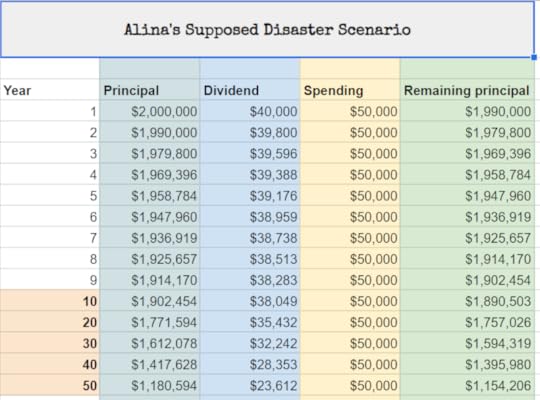
Uh-oh. So the worst things have happened in many areas of her economic life, and Alina lives out the next 40 years of her life and dies with only $1,395,000 in the account. What a harrowing close call!
But what if things turned out worse than the worst? Despite our best efforts to make her go bankrupt, she still died a millionaire. So we need to get a little more Mad Max in our scenario:
Alina: Fury Road
The US decides to cripple its own economy forever so there is no more innovation, no productivity, and all dividends are halted and yet our 330 million citizens all decide to go along with it.
Amid the chaos and the dune buggy machine gun battles which rage day and night in the street, her wealth drains by $100,000 every year and she is down to a single million by age 60. But she keeps up the spending and refuses to make any changes. She’s broke by age 70 but just sticks to her favorite activities which are rewarding and engaging but never produce a penny of income.
Her mortgage checks start to bounce. The bank eventually enters foreclosure but she remains glued to that house. After another year, the foreclosure is complete and the sheriff arrives to drag her wiry 71-year-old frame out of the house, kicking all the way.
Alina is eligible for social programs, but rejects them all. She has a huge network of friends, but doesn’t accept any of their offers for help or employment.
She checks into a nice all-suites hotel and starts paying all her bills with credit cards, maxing them all out including some cash advances to keep the money flowing. With the usual tricks of balance transfers and delayed-repayment plans, she keeps the party going for two more years, until all the credit cards have been canceled and sent off to collections.
At age 73, Alina is finally out of money. She cannot buy food or shelter and she has finally arrived at a reality that homeless people currently experience every day right now. But we had to make up an absolutely ridiculous and frankly impossible story to get her there.
I’ll spare you the long story of Dave’s decline, but it’s equally impossible.
Dave’s Doubtful Demise
If he quit his job today, stopped airbnbing his house and just enjoyed the whole thing and never even rented out the lower level, forfeited his six-figure 401k account and social security and everything else except the rental properties and the $1000 from local gigs, this would happen:
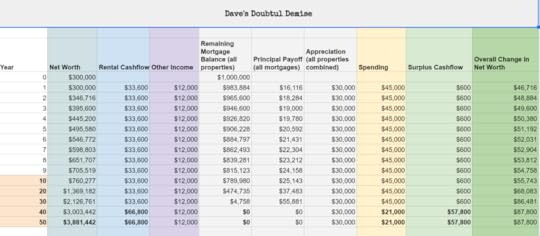
What the heck!?
We threw Dave into the worst of situations, something far beyond just quitting his crappy day job and arguably impossible. Yet not only does his cashflow continue to increase, but his net worth skyrockets by about $50,000 per year, ending up at almost $4 million dollars (inflation-adjusted too) by the time he kicks the bucket at 90 years old.
In reality, that purple “other income” column is likely to be triple what the spreadsheet says, his 401(k) account will definitely continue to exist and grow, and many other good things will happen.
More Realistic Projections for Both Of My Friends
If you’re a pessimist, you may have looked at all of those numbers above and said, “Hmm yeah they made it, but it was a little close”. But remember, these were worst case scenarios. It is foolish to plan everything in your life around the worst case scenario, because it will often result in you having the minimum possible amount of fun.
So instead, you need to at least include a conservative estimate of what is most likely to happen. And I’ve done so for both Alina an Dave, creating these graphs of the results
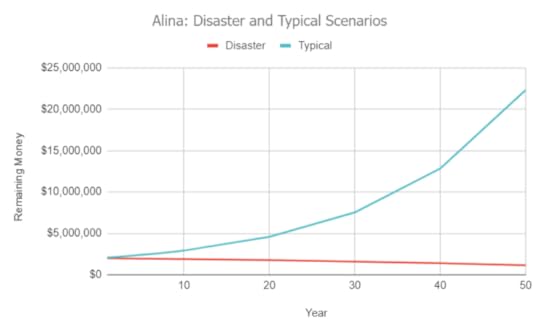 Alina grows exponentially richer over time, due to having a large stock portfolio that she never really touches.
Alina grows exponentially richer over time, due to having a large stock portfolio that she never really touches.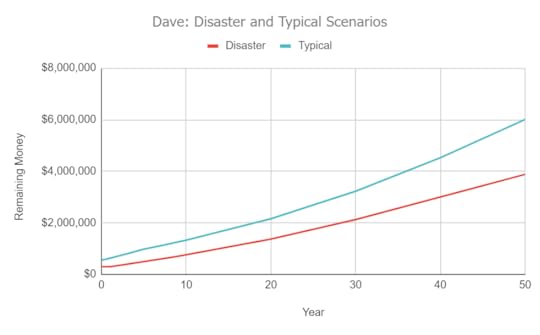 Dave does incredibly well too, even starting from a much smaller initial net worth.
Dave does incredibly well too, even starting from a much smaller initial net worth. So, both of these friends can not only quit working, they can also start splashing out more money on whatever they want. Congratulations to both of you!
Both of them, and more importantly a large percentage of MMM readers, possibly including YOU, are beyond the point where they could ever run out of money even if they quit their jobs today.
And they need to see this wonderful truth for what it is, so that they can confidently act on it, so that they can stop giving away precious months of their lives away to their employers, to amass still more chunks of easy money, to add to a pile that they will never, ever, ever need.
And then they can start experiencing actual reality of early retirement, which is as follows:
Your spending ends up a little bit lower than you expected, despite your best efforts to splurge on yourself and be generous to others.Your investments do keep going up over the long run, exceeding those conservative forecasts you made.You do end up making bits of money here and there (in Dave’s case shit-tons of money), even though you absolutely don’t need it.As the decades pass and you settle into this pattern, you realize that money is not one of your worries. Life as a Human Being still presents plenty of challenges, but holy shit, thank goodness you quit working when you did because it was completely unnecessary. Looking back, you probably should have done it several years earlier.If any of this sounds familiar, congratulations – you will never run out of money which means you need to stop letting it rule your life.
Quit your job.
Seriously.
Sheesh. What are you waiting for?!
Epilogue: Mr Money Mustache Chills out for a Splurge too:
Writing this article reminded me that I too can still be a victim of excessively frugal habits. Sure, my house is beautiful and I have great food, cars, tools, bikes and everything else. But when it comes to travel, I start playing silly games with myself.
For example, my boy and I are heading to Canada later this month to visit the family. And against all logic, I noticed the Nagging Voices of Cheapness starting to chatter in my head.
“These plane tickets were only $210 each – can I really justify paying an extra $80 for a bigger seat at the front of the plane? And sheesh, how can I get around the $150 roundtrip Uber ride (or $150 roundtrip driving+parking) to the airport, that’s ALMOST AS MUCH AS THE PLANE TICKET! Should we spend an extra 3 hours roundtrip to save $100 by taking the bus?” And then what about our transportation once we’re in Canada? Bus? Car rental? Train tickets? How does the $7.00 per gallon gasoline factor into this given that we need to travel over 800 miles during our time there?
Blah blah blah. The correct answer is “Shut up, Mustache! You should do whatever you think is most fun and least stressful, without thinking about the money.”
For me, this means driving my nice electric car on the speedy toll road to the expensive Denver Airport parking lot so we can walk right into the terminal with no shuttle. It also means sitting in a good plane seat, and then taking the least stressful and most fun form of transportation once I get there.
Why? Because the difference between the cheapest and most stressful trip, and the most expensive one in this case, is only about one thousand dollars.
Even if I did this every single year for the rest of my life, I’d blow $50,000 on luxurious trips to visit my family (and I could drive my Mom to her 125th birthday in style!)
And based on my own worst-case spreadsheet, I am never going to wake up and think,
“Damn, if I just had one thousand more dollars, or even fifty thousand dollars more in this net worth column, I’d be a happier person”
So I get to relax, and enjoy my trip, and guess what I even did this:
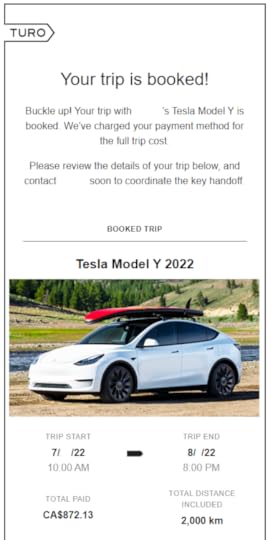
So I’ll see you in retirement, and maybe even in Canada later this month!
Further Homework for Spreadsheet Lovers:
I have shared a copy of the Google Sheets spreadsheet I made for these examples and graphs here. You should be able to “file->make a copy” to get an editable version to mess around with. Mine are pretty basic and leave out some details in order to avoid getting any more complicated than they already are, but feel free to add more if you like,
In the Comments:
Are you too fearful, or too optimistic, or somewhere in between? If you have already quit your job, how did you get the confidence? If you’re still stuck in One More Year Limbo, what would it take to get you out of it?
June 21, 2022
Which is Safer: Rental Houses or Stock Investments? (a Case Study)
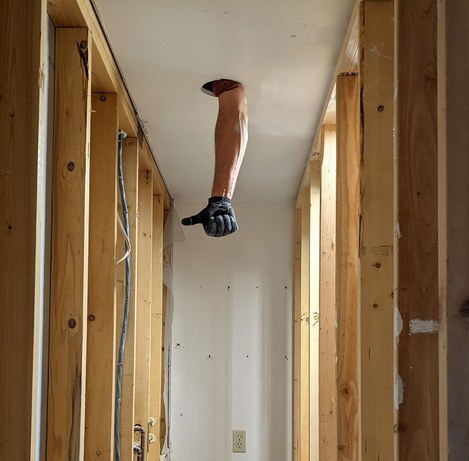
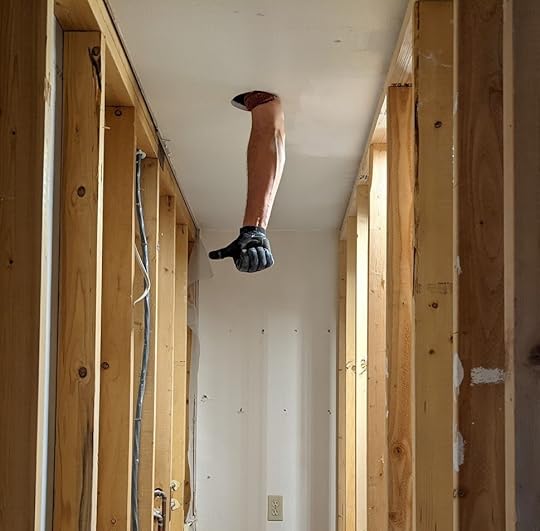 Another fine day in Retirement
Another fine day in RetirementDuring our recent discussion on Inflation, a Badass reader stopped by and caught my attention by dropping the following block of wisdom into the comments section:
“A final note if you are worried about inflation: sledgehammer the TV and go for a walk in the woods. Trees get bigger every year unless you cut them down.”
That sentence was just one piece of a sizable rant that this gentleman named Aaron contributed at the time, and I applauded him for sharing it. Little did I know he was about to hit me with a case study request that struck home in so many ways that I knew we had to cover it right away.
At the root of his question is the core of what it means to “Retire”.
According to my own definition, you don’t have to stop working. But you do have to build up a level of freedom and wealth such that the work you do is entirely by choice, rather than something you grit your teeth and crank through just because you need or want the money.
After all, the real purpose of work is to create something that is meaningful to you. Why would you ever want to quit that?
Aaron Writes
Dear MMM,
I’m a 47 year old contractor with a small remodeling business with five employees. My four kids are now grown. We live below our means in a nice house I built 16 years ago on 25 acres we will never leave…we love it.
In addition, we own a beautiful 1860s log cabin/ timber frame home we spent three years and tons of money rescuing/renovating and now rent out on Airbnb.
We are in the process of selling two other houses: one former home that our youngest daughter will be purchasing, and a second one that my crew and I are almost done fixing up.
Knowing myself, I will likely buy another fixer with the money, or some more land…when the price and condition is correct… but I have also always been fascinated by the stock market.
We do not currently own stocks or index funds, and we have no debt. I recently cut my workdays down to four a week, and am pretty happy with that for now.
But, I did some math and if we sold the Airbnb with the other two houses, we’d have a chunk of cash big enough for me to mostly retire – working only if I really felt like it.
So the stock market is down and it’s time to sell the real estate and throw that into VTI, right?
I’m a hands-on guy so it seems strange to turn three houses I can see, touch and feel into some numbers on a computer screen in the form of VTI. Not sure if I want to do that, even if it makes sense to my math brain.
What else besides stocks or rental real estate could I do with the money to secure a 4% withdrawal rate in retirement?
—-
So you can probably see why I can relate to Aaron’s question. As another 47-year-old carpenter who also values manual labor, peaceful forests and throwing out salty comments in response to the whiny laments of the financial media, I can see exactly where he’s coming from.
On the other hand, I am also very comfortable with stock market investments as a source of long-term wealth and security, and I have more than three quarters of my life savings invested in index funds (the remainder just being my house and other local real estate and very small business ventures with friends).
So perhaps the main difference between Aaron and myself is that I think of houses and stocks as being two versions of the same thing. They are both real, concrete, productive assets rather than gambling instruments or numbers on a computer screen. If you understand this connection, you will become a better lifetime investor. Meanwhile, people who understand only one side or the other may become blind to what investing really means.
The Real Estate faithful will often talk about the concrete nature of their investments. Their houses and apartments really exist, and they provide the service of housing to their tenants which is an essential human need. In exchange for meeting this need, the investor collects rent which is a genuine and sustainable source of income.
And your ownership of the houses and apartments is guaranteed and protected by our legal system and financial institutions, something which allows trust. And trust is the foundation of a society’s wealth.
But sometimes these people will go too far and insist that real estate is the only true investment – becoming blind to the value of investing in other businesses via stock ownership. This blindness can lead to “crusty multimillionaire landlord syndrome” – the guy who owns 400 rental units and is always looking for the next deal, yet can never truly sit back and feel retired, no matter how big the empire grows. Because for most people, real estate ownership is an active business rather than a truly passive investment.
The Stock Market Faithful may develop a different problem: a focus on stock prices rather than business ownership. When you hear people talk about the “200 day moving average” or “support level” or “death cross pattern”, you can safely assume they suffer from this condition.
And it’s the same thing that powers price speculation on things like cryptocoins, meme stocks and other volatile fads: they are hoping for an outcome (rising asset prices) without considering the thing that actually creates the underlying value (earnings).
 Meme Stock / Crypto Trader
Meme Stock / Crypto TraderIf there are no earnings, there is no value. Betting otherwise is like trying to get in shape by strapping on a fake Batman-style padded muscle costume instead of doing the actual barbell exercises.
But equally important, a stock is also a guaranteed slice of ownership of a real business, protected by our legal system and financial institutions just like the deed to your house. Although you can easily buy and sell stocks with a single tap on your phone, the actual meaning of stock ownership is complex and old-fashioned and regulated and that’s a good thing. You are a shareholder, entitled to receive company financial statements, attend shareholder meetings, vote on company initiatives, and even hire and fire board members (or become one yourself) using your voting rights.
With no trust in these institutions, including the democratic election system that allows us to keep everything going, there is no value to the idea of owning anything, and a wealthy society cannot develop. Recording the ownership data onto blockchain won’t make any difference, because accurate recording is not the core issue.
What matters is that humans need to trust each other, and behave in a trustworthy way in order to keep all this prosperity going. If you give up on trust and fuck with democracy and start spreading mental viruses to encourage others to bicker and mistrust each other, all forms of wealth start to crumble.
However, as democracy-loving, enthusiastically-voting-in-every-election-even-the-midterms members of a rich society, you and I Iean firmly towards the side of trust and cooperation, which is why our lives are looking so prosperous these days.
To bring these two philosophies together, I encourage people to think of every investment as just a different type of rental house. What value does the house (or company) deliver to society, and what are its earnings relative to the price you are paying?
For example, earlier this year some friends and I were discussing Rivian, the hot new electric truck startup as it was about to go public.
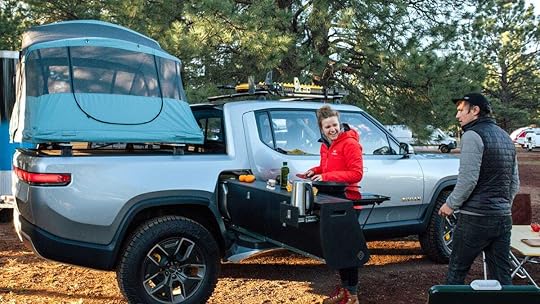 (Fancy electric truck with slide-out camp kitchen. Image credit Rivian)
(Fancy electric truck with slide-out camp kitchen. Image credit Rivian)“Wow, that R1T is an amazing vehicle – every wealthy outdoorsy person wants one and all the reviews are glowing. So the IPO is probably a good investment at $75 per share, right?”, said my friend.
“I agree absolutely”, I replied, “it’s a cool truck and heck if they sell it in the actually-useful format of a VAN someday, I’d even buy one myself!”
But the real question is how much of the company are you getting for that $75, and when will the company have enough profits to justify the price?”
At this point we could have tried to dive deeper into the details: Rivian was issuing about one billion shares, meaning you’re valuing the company at $75 billion. So you could try to take a guess at how long until the company produces enough profit to justify this company value. Which in turn depends on their gross margins, which depend on quickly and efficiently they can scale up multiple factories and secure a stream of several thousand custom components and batteries…
But, not being blessed with the power of infinite knowledge of Rivian or a psychic ability to foresee the future of the automotive industry. I’m not qualified to speculate on the value of these shares. So instead I just buy the whole index and get the great performance of a wide blend of companies, without suffering the unique risks of concentrating in one individual stock.
And as it turned out, that was a good philosophy if you look at Rivian’s stock price since that fateful IPO:
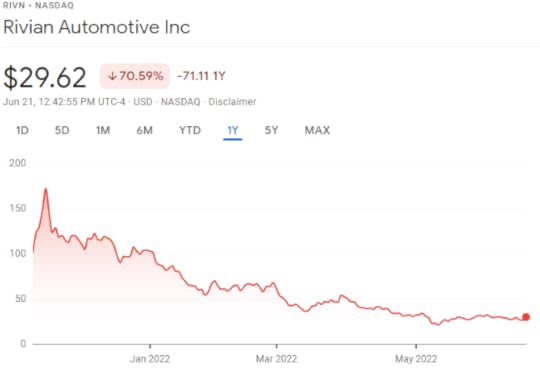 Buying a hot stock at IPO can make you look like a genius or a fool – but it’s mostly luck either way.
Buying a hot stock at IPO can make you look like a genius or a fool – but it’s mostly luck either way.So what does this have to do with Aaron’s question?
Aaron knows how to spot a good deal on a house (which is like buying shares in a productive company), and he has the incredibly valuable skill of being able to renovate them to create new value (which is like helping his new “company” upgrade its factory to deliver even better earnings.)
But he should also be open to investing in other companies (through stock index funds) because they are just doing the same thing in different ways. They’ll deliver a solid and consistent return over the coming decades. While a well-managed rental house can sometimes deliver higher returns than the stock market, a stock never calls you on a Sunday night to say the water heater is leaking or warn you that they need to break their lease early because they got a new job in another state.
And Aaron is taking it a few staircases further still – actively building new stuff and managing five employees – a meaningful pastime to be sure, but definitely not in line with my own idea of retirement.
As he and I have both learned at this age, construction is fun but it also places a massive strain on the body. Rental houses are fun, but shit can get old eventually and sometimes you just want to sit back on a Sunday afternoon rather than fielding calls from your tenant or your property manager.
In contrast, stock investment is a truly passive way to set yourself up for the best kind of retirement: one where you do the work you love, but you really don’t need the money.
So what would I do in Aaron’s shoes?
I’d keep the houses that I love to live in, and sell the rest if I’m only managing them for the money. I would dump a huge chunk of surplus cash into the sensible index funds through the financial firm of my choice, feeling extra good about the fact that stocks are currently on sale.
And then I’d keep doing construction projects alongside great friends just as I do now, only when it suits me. When evaluating a new project, instead of asking myself about the potential profit, I would ask, “Is this project so worthwhile that I would do it for free?”
If the answer is yes, go ahead and do it and celebrate the profits and use them to facilitate even more generosity.
If the answer is no, the project is a no – you’d be taking it on just to make money, which is something you no longer need, because you have already arrived at financial independence. Leave the money in index funds and keep searching for work that you really care about.
From what I’ve seen, valuable, fun, worthwhile work is an infinitely renewable resource and we both have at least another 47 years of it ahead of us.
Good luck Aaron!
In the Comments: Are you a Stock Market or Real Estate Faithful, or Undecided and still figuring it out?




May 20, 2022
Finally, a Stock Market Crash!

 Boom!
Boom!Well, that was kinda sudden!
In the three months or so since we last spoke, the world has become an entirely different place – at least for those of us who keep up with any sort of international, financial or stock market news.
The headlines are new, and the problems are of course very real. Russia has started one of the biggest, shittiest wars in a generation – killing untold thousands of people, displacing millions, and halting trillions of dollars of production and trade. This has compounded the “everything shortage” of broken supply chains that we have all been feeling for the past two years, creating even more inflation especially in oil prices. And just to amplify everything even further, China has launched a batshit crazy (and medically impossible) “zero covid” policy, locking down hundreds of millions of its own people who can no longer produce or export the things that the rest of the world’s economy had grown to rely upon.
The resulting shortage of goods and workers has created rising prices (inflation), which has triggered our central bankers to finally rise from their slumber and start jacking up interest rates.
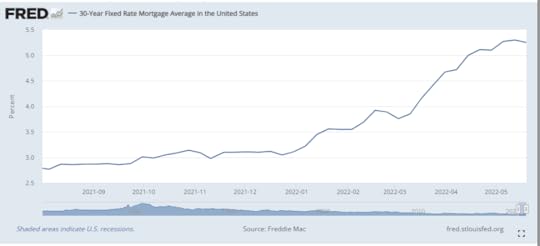 Slamming on the Brakes: Mortgage rates have almost doubled in just nine months.
Slamming on the Brakes: Mortgage rates have almost doubled in just nine months.Which has in turn triggered the more skittish stock investors to run for the exits and completely change their view of our economic future, flooding the financial news with red ink and scary headlines.
The bottom line is that the overall US stock market is down about 20% over the past three months. Which means that if you add up your net worth as I do occasionally, you may find that almost a fifth of it has suddenly gone up in smoke.
Fortunately, this is just an illusion. While the human side of every war is awful and you should help out if you can, the financial side of this panic is very normal and we were overdue for something like this to happen.
A 20% drop in stock prices is called a “bear market” and they traditionally happen every few years, lasting just 9 months or so from top to bottom. But in the Mustachian Era (the years since 2011 when I started writing this blog), there has only been one: the 2020 Covid Crash which only lasted about a month. Heck, even in my 25 year investing lifetime (roughly 1997 to present), there have only been a handful:
Bear market dateDecline (peak to trough)Duration (months)March 2000 – Sept 2001 (dotcom bust)-36%18Jan – October 2002 (more dotcom+housing)-34%910/9/2007–11/20/2008 (great financial crisis)-52%14Jan – Mar 2009 (more GFC)-28%2Feb-March 2020 (covid crash)-34%1April 2022 – ??? (the current blowup)-20% so farWhat’s your guess?Data source: S&P market data.
So if you’re under 40, some of this may feel unfamiliar.
Now that we’ve covered the background, we can get into some better news:
This is all a normal, healthy part of the economic cycle. In fact, our central bankers have deliberately created this situation for your own good and they probably should have done it a year ago.If you are still buying or holding shares (as opposed to actively selling them), this stock market crash is actually making you richerEven if you are retired and living entirely off of your investments, stock market declines are to be expected and should not derail your life of leisure – as long as you are following a rough approximation of the 4% rule and remain flexible and understand the concept of a Safety Margin.If you really understand the points above and really feel excited about them, you can drop the fear and stress out of your investing life, which means you will live a life that is both wealthier, and more fun. So let’s cover each point properly, so you can be excited about all this as I am.
1) Why is this healthy again?
First, the part about the Federal Reserve and why a central banking system is so useful (despite the claims of financial anarchists like Bitcoin lovers):

When something bad happens (like the sudden deliberate recession we caused due to our own 2020 Covid shutdowns), the Fed can drop interest rates and “print money” in other ways to boost investment and demand in the economy. And it works – this is why our economy bounced back so quickly from the largest slowdown in history.
Some might say it worked too well – while we have benefited from record low unemployment, we have also seen prices of houses, stocks, and everything else rise with alarming speed. So eventually, they had to turn off the booster.
By raising interest rates, the central bankers put a slight drag on business spending, consumer borrowing and stock market exuberance. This lowers demand for everything, which pours some cold water on inflation. The deflating of the most overpriced stocks shows that the policy is working. And over the next year, higher mortgage rates should also end the crazy bidding war of a housing market we’ve been seeing in most cities.
But stock market crashes and even brief recessions are good for more than just fighting inflation. They’re good for fighting a persistent flaw in human nature itself.
Humans are lazy creatures at heart. When things get too easy, we lose our edge and our motivation to learn, innovate and make changes. It happens at the individual level, as I notice when I waste certain evenings on the couch accomplishing nothing. And it happens even more in the collective sense, if a group of people secures a nice stream of power and profit that remains unchallenged.
Imagine that you’re running a company. Your customers keep buying your stuff no matter what you do, investors bid your stock price up to the moon regardless of your financial performance, and there is no competition on the horizon. What do you think will happen to your monopoly?
There’s no need to speculate on this, because it has happened to varying degrees since the beginning of economic time. The answer is that you start to suck. Your product innovation stagnates, your customers grow less and less happy, and your investors grow nervous. Eventually, something comes along to poke at this bubble of complacency – in this case war and covid and inflation – and then POP! – your sales dry up, your stock price crashes, and your cozy corporate desk has turned into a tattered lawn chair in the parking lot and your business is done.
But wait! While you were adding that final layer of lipstick to your obsolete film camera or manual typewriter or gasoline-powered line of cars and trucks, there actually were competitors out there, inventing better products and offering better customer service and keeping their balance sheets lean, because they had to, because things for them were hard.
Your inefficient company goes out of business, and your more nimble competitors welcome your former customers. They may even suck up the best of your former employees and buy your old factory to start making new, better products.
This happens all the time, and while it can be painful for those who weren’t prepared, it’s a healthy thing for business overall. And a healthy thing for overpriced housing markets, and the speculatively inflated prices of oil, lumber, copper and everything else.
To a certain extent, the high prices were useful in sending a signal that we need to produce more of these things. But beyond that limit, people started buying overpriced stocks, houses, cryptocoins and commodities simply because they hoped to make a quick buck by flipping them to someone else at a higher price. Instead of investing in a productive asset, these speculators were just assuming the recent momentum would continue. This type of gambling is a waste of everyone’s time, and a good price crash is the way we flush the financial toilet.
2) My net worth has just cratered by 20%. How exactly does this mean I am getting richer?
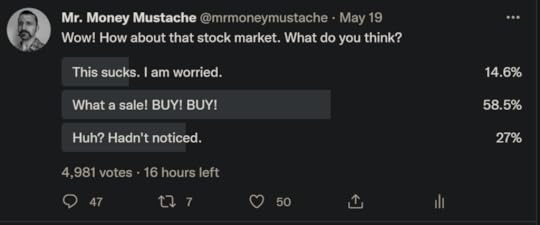 Results of a recent Twitter poll – Mustachians are well ahead of average Americans, of whom only about 18% consider this a buying opportunity (!)
Results of a recent Twitter poll – Mustachians are well ahead of average Americans, of whom only about 18% consider this a buying opportunity (!)The first thing to ask yourself is, “20% of what?”
Sure, stock prices are down from a recent peak, but that peak itself was just an arbitrary fleeting moment of investor enthusiasm. Was that previous price really the “right” value for stocks, or did you just grow attached to it because of our known human weakness of Loss Aversion?
To put it another way, what if instead of looking at our investments as the financial media likes to portray them, which is like this:
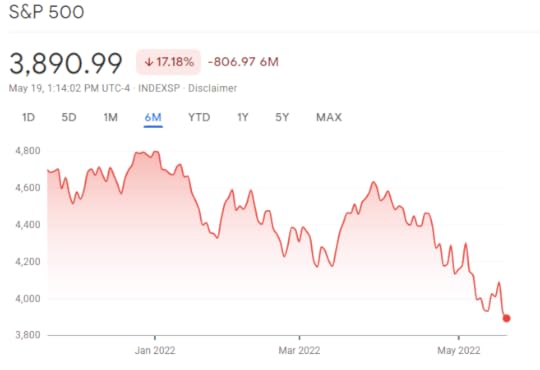 Financial media: “Aaack, scary red line just dropped to ZERO!!!”
Financial media: “Aaack, scary red line just dropped to ZERO!!!”What if we decided to be more sensible, start the damned Y axis at zero as every graph should do, and zoom out to a reasonable time horizon,such as the Age of Mustachianism which happened to begin in 2011. And ignore the wiggly blue line and follow the more meaningful red line.
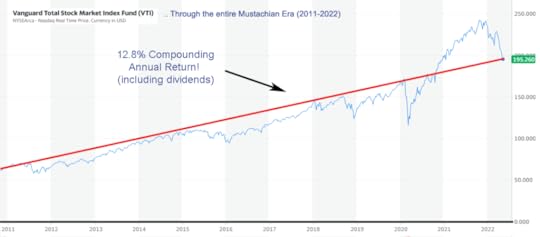 More accurate representation: “Whoa, stocks are a great long-term investment!”
More accurate representation: “Whoa, stocks are a great long-term investment!”Well, how interesting. Not only has this crash returned us to a roughly straight line of longer term stock market growth, but that line itself is very generous, representing a 12.8% annual compound gain if you factor in a quarterly reinvestment of dividends (which typically add about 2% to your annual returns but aren’t shown in these charts). Over longer periods like 50 years, stock returns have been closer to 10% after dividends, which means we’ve still had more than our share of good times.
In the long return, stock prices are determined by this formula:
Stock price = company earnings x BRM*
*(Bullshit Random Multiplier)
The BRM, more formally known as the Price-to-Earnings ratio or P/E, is supposed to be based on a mathematical estimate of the present value of all future dividends you will receive if you hold a stock for the entire life of the company.
When we expect higher interest rates or inflation over the next 20 years, the P/E should fall because those distant future earnings become worth less in today’s dollars. Meanwhile, if we somehow realize that the long-term future of the business world is even more rosy than we thought, the P/E should rise because investors can accurately predict a larger stream of future earnings.
But the “bullshit” factor comes in due to things like the “He Said She Said” nature of whatever Elon posted on Twitter today, momentum trading algorithms, meme stock traders banding together to drive up random stocks regardless of underlying value, and more. In short, the short term BRM is just a measure of the present moment’s balance of greed and fear.
As an investor, however, you don’t care about the BRM. In fact, you don’t even really care about the share prices of your investments, because the price of an individual share only matters twice in your lifetime:
The moment you buy it, And the moment you sell it.Everything else is just silly noise.
Right now, most of us are still earning money and accumulating more shares. Even Mr. Money Mustache, as a person who retired 17 years ago, is still in this boat for the simple reason that my retirement income from dividends and hobby businesses is still greater than my annual living expenses (which still hover around $20,000 per year).
On top of this, if you are holding mostly index funds as you should be, your stocks deliver a nice helping of dividends every three months, which you have set to automatically reinvest into still more shares of those same index funds. In today’s market, you are getting about 20% more shares for each dollar that you invest. Which translates to a full 20% more wealth from those shares in your future.
3) Okay, but I really am retired and trying to live off my investments now. How is this not a disaster for me?
First of all, you’re still getting the dividends that we celebrated in point 2) above. When the stock market crashes, dividend payments usually remain far more stable because the big, established companies in your index funds continue to make money.
It’s quite similar to owning a portfolio of rental houses spread throughout the world: while house prices fluctuate all the time in different cities, the total rent paid by a group of thousands of tenants will tend to remain pretty stable and just rise at the rate of inflation.
So this stream of money will keep coming in and covering a substantial portion of your living expenses (between 30% and 50% for most retirees in today’s market conditions if you retired using the 4% rule).
Even if you don’t adjust your spending or income during this bear market, the end result is that you simply need to sell a tiny percentage of your shares at a discount during the bear market – which means your portfolio shrinks a bit faster.
But the 4% rule already takes this into account: if there were no such thing as bear markets, the safe withdrawal rate would actually be equal to the long-term average of stock market growth, which is closer to 7% after inflation. By sticking to 4% or slightly less, you are giving yourself a high chance of weathering the storm.
cFireSim: Economic History to the Rescue!
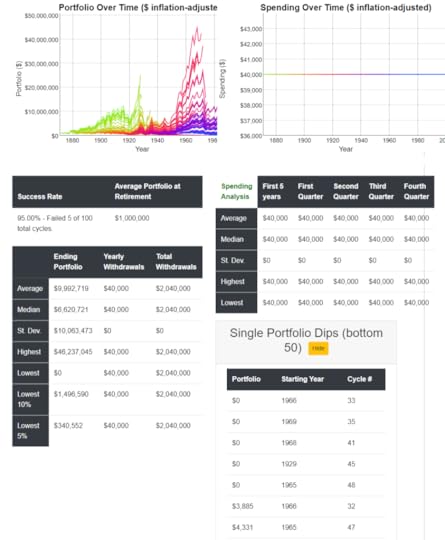 What if I “retired” at age 47 on $1 million, hoping to spend $40k (rising with inflation) for the next 50 years?
What if I “retired” at age 47 on $1 million, hoping to spend $40k (rising with inflation) for the next 50 years? Assuming a small $1k boost from social security in my 60s, I’d have a 95% historical success rate. Only the Great Depression and the 1960s slump would have foiled this plan, and even then just barely.
To really understand what this means I reached out to Lauren Boland, the financial calculations wizard behind the amazing cFireSim retirement simulator. Her long-running site gives you the best shot at answering the question: “If I retire with a fixed chunk of money, what are my chances of success?”
I asked her what it really means when the stock market drops: does a 20% drop really make you 20% less “retired” or is actual outcome more subtle? True to form, she got back to me within just a few minutes with these thoughts:
MMM: How should potential retirees think of the recent crash in valuation – has it really pushed out their retirement date, or not?
Lauren:
It depends on how flexible you are willing to be with your spending. As stocks get more expensive (a higher price-to-earnings ratio), it can be a perfect time to spend more (take those gains), and when they drop in value (like right now), you may want to spend less to preserve your capital.
We have a name for the this idea of stock crashes that come at just the wrong time: the Sequence of Returns Risk. If you retire just BEFORE a big stock market crash, your first few months or years will drain your portfolio a bit more than you expected, until stock prices recover. So, recent retirees are living this right now if they retired without much safety margin.
On the other hand, If you HAVEN’T retired yet, and your numbers still look good even now, I think it may actually be a better time to retire, since you can hope that history repeats itself and there is a recovery. It’d be like retiring at the bottom of 2009 with still-decent numbers.
— (thanks Lauren!) —
Okay, so we’re probably not screwed either way. But still, as a Mustachian this seems like a great excuse to refer to point #1 above: use the chaos and disruption as an excuse to make yourself stronger. Become more efficient with your spending, find enjoyable ways to create value for others that happen to produce money for you as well, and improve your exercise, eating and personal growth programs as well. Because hey, why not?
Epilogue: How does all this Misery end?
Although you now understand that even the current situation is normal and healthy, there is even better news at the core of it: It’s a self-correcting problem, and the solution is already in the works.
A shortage of goods, a sloshing overflow of the money supply and inappropriately low interest rates led to everything getting more expensive. But meanwhile, companies have built more factories and hired more workers to increase production and now the central banks have cranked up interest rates and reversed their other support programs as well.
The result: mortgages cost more so housing sales have slowed. Consumers and businesses are both pissed off by recent price increases and more cautious about the future so they are buying less stuff, which reduces the Everything-Shortage that we mentioned earlier. Suddenly, supply catches up to demand and prices stop rising.
Or to summarize all of this in a much pithier way: the solution to high prices, is high prices.
The world is scary and the stock market has plunged, but the fundamental picture hasn’t changed at all: billions of humans are working hard and applying their ingenuity every day to get ahead. It’s a messy process, but on average we continue to succeed at this task over time. People who understand this unchanging mechanism will look at this year’s sale on productive asset and say, “Cool – sign me up for another helping of future wealth, and thanks for the deal!”
In the comments – what are YOU doing in response to this bear market? Are you scared, or doubling down on investing?




Mr. Money Mustache's Blog
- Mr. Money Mustache's profile
- 60 followers



